Evaluating Management Accounting Systems for Creams Ltd
VerifiedAdded on 2023/01/11
|20
|4891
|94
Report
AI Summary
This report provides a comprehensive analysis of management accounting principles and their application within Creams Ltd, a confectionery company. It begins by defining management accounting (MA) and emphasizing its significance, contrasting it with financial accounting and highlighting the internal focus of MA in aiding managerial decision-making. The report details various MA systems, including cost accounting, job costing, inventory management, and price optimization, evaluating their benefits and applications. It then describes different reporting techniques under MA, such as budget reports, accounts receivable reports, cost accounting reports, and performance reports. The report further delves into specific MA tools like absorption costing and marginal costing, demonstrating their application through income statement preparation. It includes computations and interpretations of financial data. The report also compares and contrasts the ways in which an entity adapt MA systems in responding towards the financial problem and also explains benefits and limitations of different planning tools. Finally, it concludes with a discussion on the advantages and applications of different budgetary control tools.
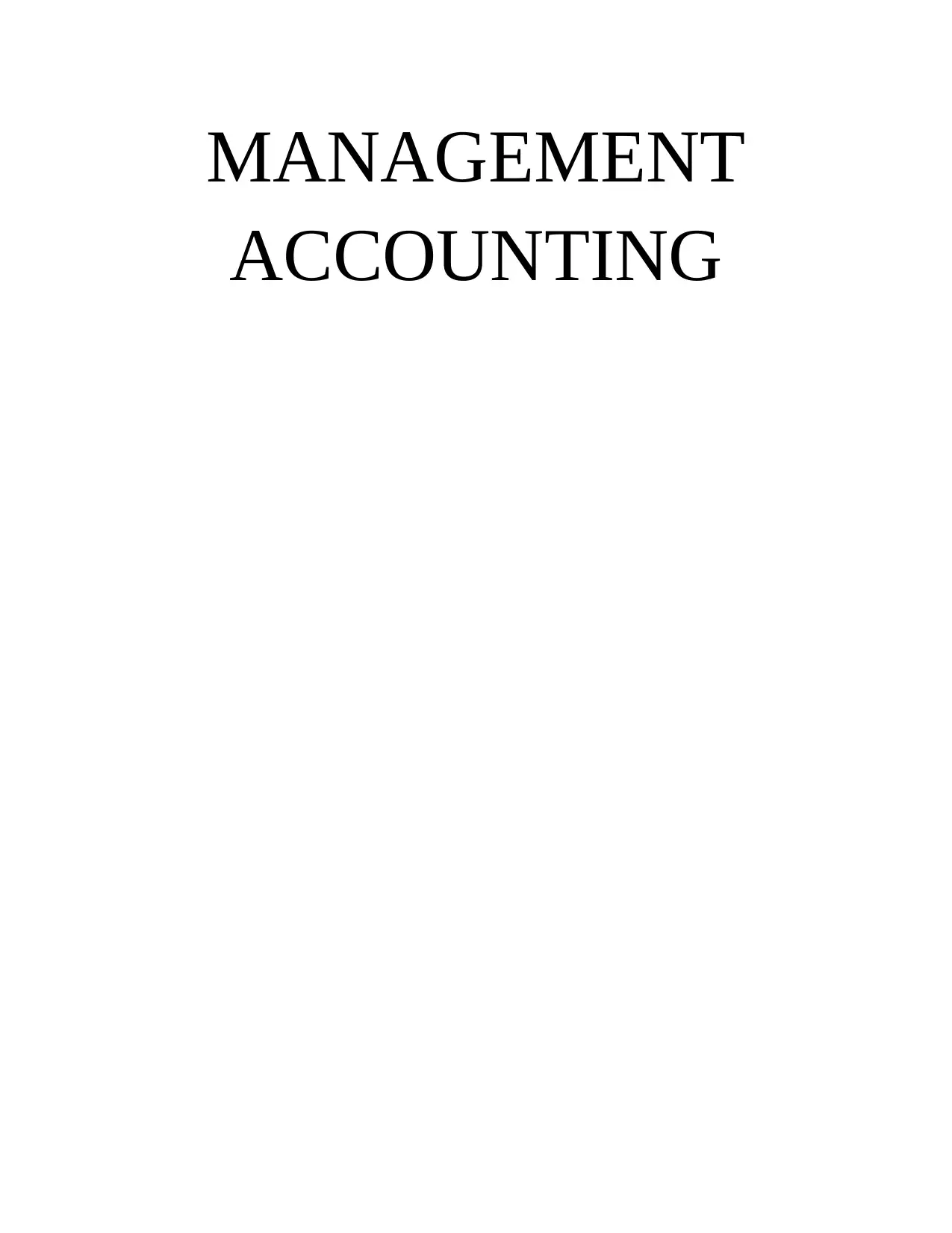
MANAGEMENT
ACCOUNTING
ACCOUNTING
Secure Best Marks with AI Grader
Need help grading? Try our AI Grader for instant feedback on your assignments.
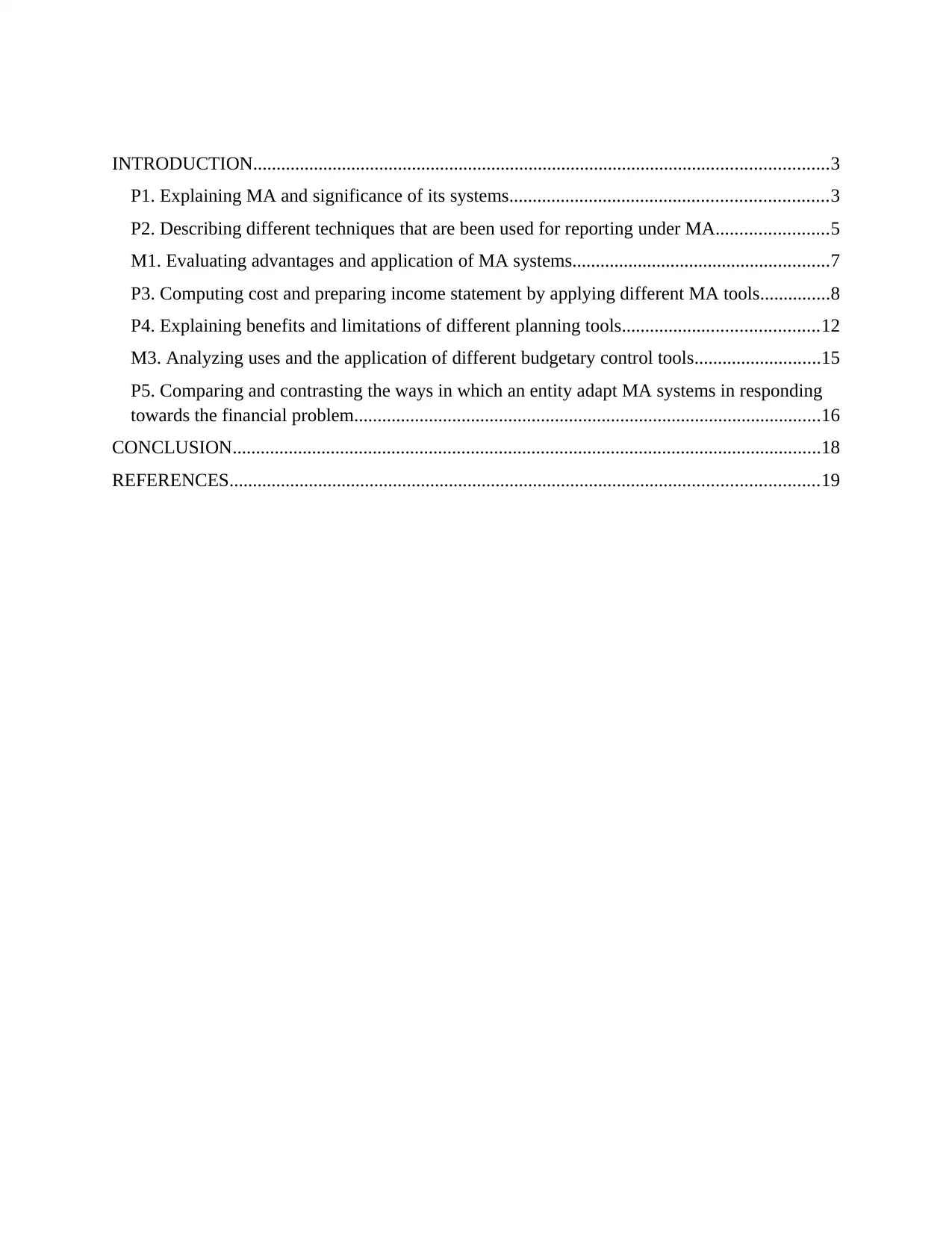
INTRODUCTION...........................................................................................................................3
P1. Explaining MA and significance of its systems....................................................................3
P2. Describing different techniques that are been used for reporting under MA........................5
M1. Evaluating advantages and application of MA systems.......................................................7
P3. Computing cost and preparing income statement by applying different MA tools...............8
P4. Explaining benefits and limitations of different planning tools..........................................12
M3. Analyzing uses and the application of different budgetary control tools...........................15
P5. Comparing and contrasting the ways in which an entity adapt MA systems in responding
towards the financial problem....................................................................................................16
CONCLUSION..............................................................................................................................18
REFERENCES..............................................................................................................................19
P1. Explaining MA and significance of its systems....................................................................3
P2. Describing different techniques that are been used for reporting under MA........................5
M1. Evaluating advantages and application of MA systems.......................................................7
P3. Computing cost and preparing income statement by applying different MA tools...............8
P4. Explaining benefits and limitations of different planning tools..........................................12
M3. Analyzing uses and the application of different budgetary control tools...........................15
P5. Comparing and contrasting the ways in which an entity adapt MA systems in responding
towards the financial problem....................................................................................................16
CONCLUSION..............................................................................................................................18
REFERENCES..............................................................................................................................19
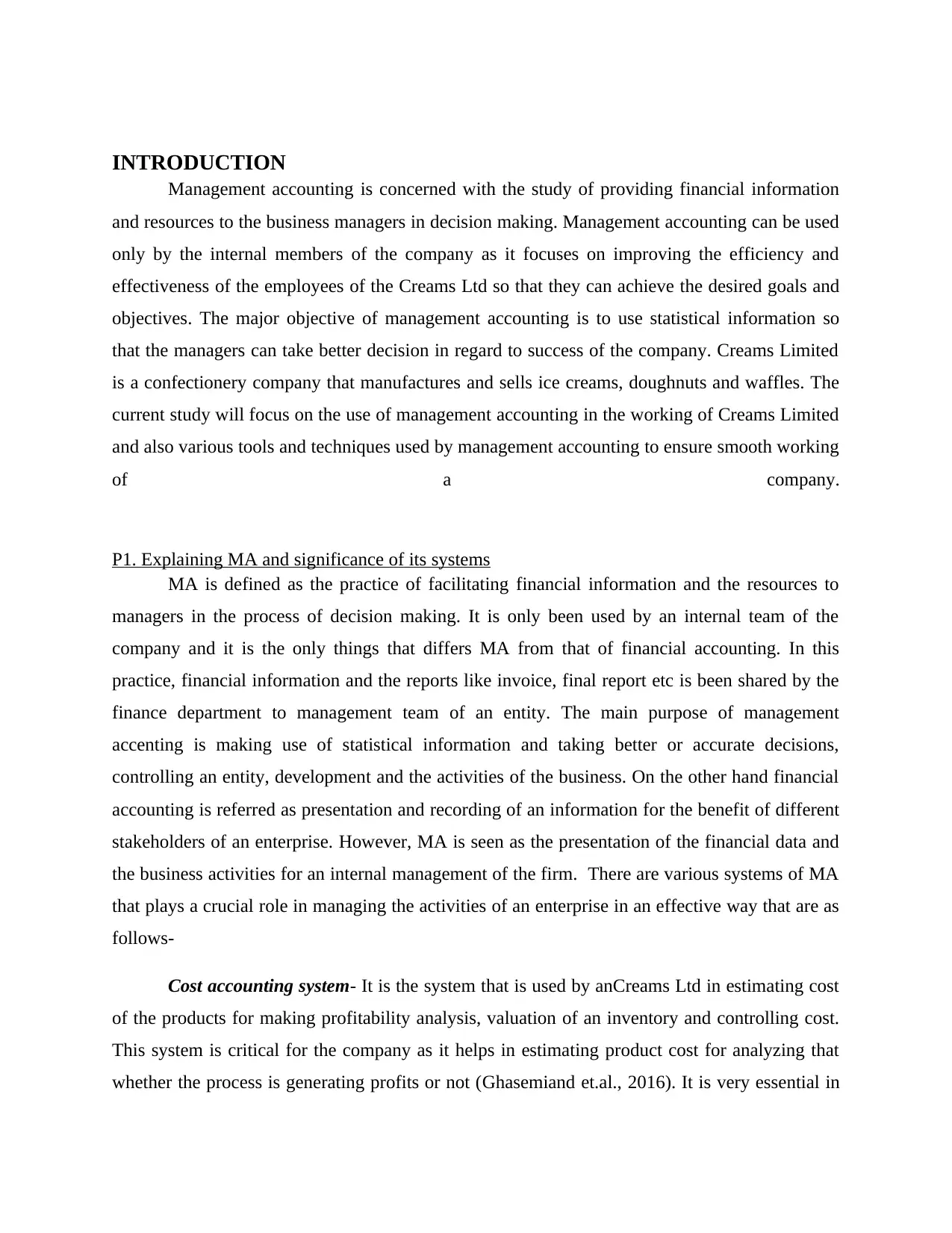
INTRODUCTION
Management accounting is concerned with the study of providing financial information
and resources to the business managers in decision making. Management accounting can be used
only by the internal members of the company as it focuses on improving the efficiency and
effectiveness of the employees of the Creams Ltd so that they can achieve the desired goals and
objectives. The major objective of management accounting is to use statistical information so
that the managers can take better decision in regard to success of the company. Creams Limited
is a confectionery company that manufactures and sells ice creams, doughnuts and waffles. The
current study will focus on the use of management accounting in the working of Creams Limited
and also various tools and techniques used by management accounting to ensure smooth working
of a company.
P1. Explaining MA and significance of its systems
MA is defined as the practice of facilitating financial information and the resources to
managers in the process of decision making. It is only been used by an internal team of the
company and it is the only things that differs MA from that of financial accounting. In this
practice, financial information and the reports like invoice, final report etc is been shared by the
finance department to management team of an entity. The main purpose of management
accenting is making use of statistical information and taking better or accurate decisions,
controlling an entity, development and the activities of the business. On the other hand financial
accounting is referred as presentation and recording of an information for the benefit of different
stakeholders of an enterprise. However, MA is seen as the presentation of the financial data and
the business activities for an internal management of the firm. There are various systems of MA
that plays a crucial role in managing the activities of an enterprise in an effective way that are as
follows-
Cost accounting system- It is the system that is used by anCreams Ltd in estimating cost
of the products for making profitability analysis, valuation of an inventory and controlling cost.
This system is critical for the company as it helps in estimating product cost for analyzing that
whether the process is generating profits or not (Ghasemiand et.al., 2016). It is very essential in
Management accounting is concerned with the study of providing financial information
and resources to the business managers in decision making. Management accounting can be used
only by the internal members of the company as it focuses on improving the efficiency and
effectiveness of the employees of the Creams Ltd so that they can achieve the desired goals and
objectives. The major objective of management accounting is to use statistical information so
that the managers can take better decision in regard to success of the company. Creams Limited
is a confectionery company that manufactures and sells ice creams, doughnuts and waffles. The
current study will focus on the use of management accounting in the working of Creams Limited
and also various tools and techniques used by management accounting to ensure smooth working
of a company.
P1. Explaining MA and significance of its systems
MA is defined as the practice of facilitating financial information and the resources to
managers in the process of decision making. It is only been used by an internal team of the
company and it is the only things that differs MA from that of financial accounting. In this
practice, financial information and the reports like invoice, final report etc is been shared by the
finance department to management team of an entity. The main purpose of management
accenting is making use of statistical information and taking better or accurate decisions,
controlling an entity, development and the activities of the business. On the other hand financial
accounting is referred as presentation and recording of an information for the benefit of different
stakeholders of an enterprise. However, MA is seen as the presentation of the financial data and
the business activities for an internal management of the firm. There are various systems of MA
that plays a crucial role in managing the activities of an enterprise in an effective way that are as
follows-
Cost accounting system- It is the system that is used by anCreams Ltd in estimating cost
of the products for making profitability analysis, valuation of an inventory and controlling cost.
This system is critical for the company as it helps in estimating product cost for analyzing that
whether the process is generating profits or not (Ghasemiand et.al., 2016). It is very essential in
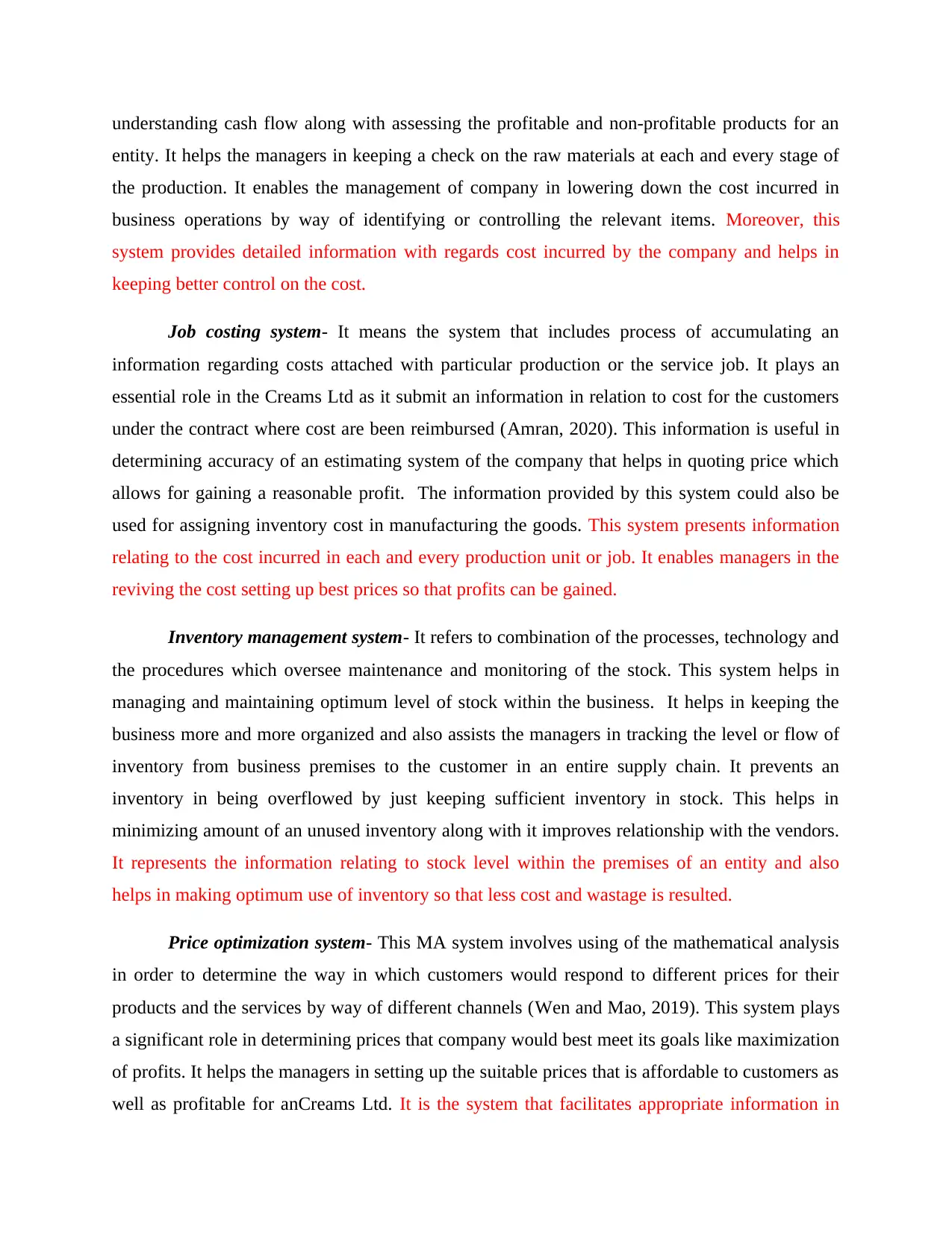
understanding cash flow along with assessing the profitable and non-profitable products for an
entity. It helps the managers in keeping a check on the raw materials at each and every stage of
the production. It enables the management of company in lowering down the cost incurred in
business operations by way of identifying or controlling the relevant items. Moreover, this
system provides detailed information with regards cost incurred by the company and helps in
keeping better control on the cost.
Job costing system- It means the system that includes process of accumulating an
information regarding costs attached with particular production or the service job. It plays an
essential role in the Creams Ltd as it submit an information in relation to cost for the customers
under the contract where cost are been reimbursed (Amran, 2020). This information is useful in
determining accuracy of an estimating system of the company that helps in quoting price which
allows for gaining a reasonable profit. The information provided by this system could also be
used for assigning inventory cost in manufacturing the goods. This system presents information
relating to the cost incurred in each and every production unit or job. It enables managers in the
reviving the cost setting up best prices so that profits can be gained.
Inventory management system- It refers to combination of the processes, technology and
the procedures which oversee maintenance and monitoring of the stock. This system helps in
managing and maintaining optimum level of stock within the business. It helps in keeping the
business more and more organized and also assists the managers in tracking the level or flow of
inventory from business premises to the customer in an entire supply chain. It prevents an
inventory in being overflowed by just keeping sufficient inventory in stock. This helps in
minimizing amount of an unused inventory along with it improves relationship with the vendors.
It represents the information relating to stock level within the premises of an entity and also
helps in making optimum use of inventory so that less cost and wastage is resulted.
Price optimization system- This MA system involves using of the mathematical analysis
in order to determine the way in which customers would respond to different prices for their
products and the services by way of different channels (Wen and Mao, 2019). This system plays
a significant role in determining prices that company would best meet its goals like maximization
of profits. It helps the managers in setting up the suitable prices that is affordable to customers as
well as profitable for anCreams Ltd. It is the system that facilitates appropriate information in
entity. It helps the managers in keeping a check on the raw materials at each and every stage of
the production. It enables the management of company in lowering down the cost incurred in
business operations by way of identifying or controlling the relevant items. Moreover, this
system provides detailed information with regards cost incurred by the company and helps in
keeping better control on the cost.
Job costing system- It means the system that includes process of accumulating an
information regarding costs attached with particular production or the service job. It plays an
essential role in the Creams Ltd as it submit an information in relation to cost for the customers
under the contract where cost are been reimbursed (Amran, 2020). This information is useful in
determining accuracy of an estimating system of the company that helps in quoting price which
allows for gaining a reasonable profit. The information provided by this system could also be
used for assigning inventory cost in manufacturing the goods. This system presents information
relating to the cost incurred in each and every production unit or job. It enables managers in the
reviving the cost setting up best prices so that profits can be gained.
Inventory management system- It refers to combination of the processes, technology and
the procedures which oversee maintenance and monitoring of the stock. This system helps in
managing and maintaining optimum level of stock within the business. It helps in keeping the
business more and more organized and also assists the managers in tracking the level or flow of
inventory from business premises to the customer in an entire supply chain. It prevents an
inventory in being overflowed by just keeping sufficient inventory in stock. This helps in
minimizing amount of an unused inventory along with it improves relationship with the vendors.
It represents the information relating to stock level within the premises of an entity and also
helps in making optimum use of inventory so that less cost and wastage is resulted.
Price optimization system- This MA system involves using of the mathematical analysis
in order to determine the way in which customers would respond to different prices for their
products and the services by way of different channels (Wen and Mao, 2019). This system plays
a significant role in determining prices that company would best meet its goals like maximization
of profits. It helps the managers in setting up the suitable prices that is affordable to customers as
well as profitable for anCreams Ltd. It is the system that facilitates appropriate information in
Secure Best Marks with AI Grader
Need help grading? Try our AI Grader for instant feedback on your assignments.
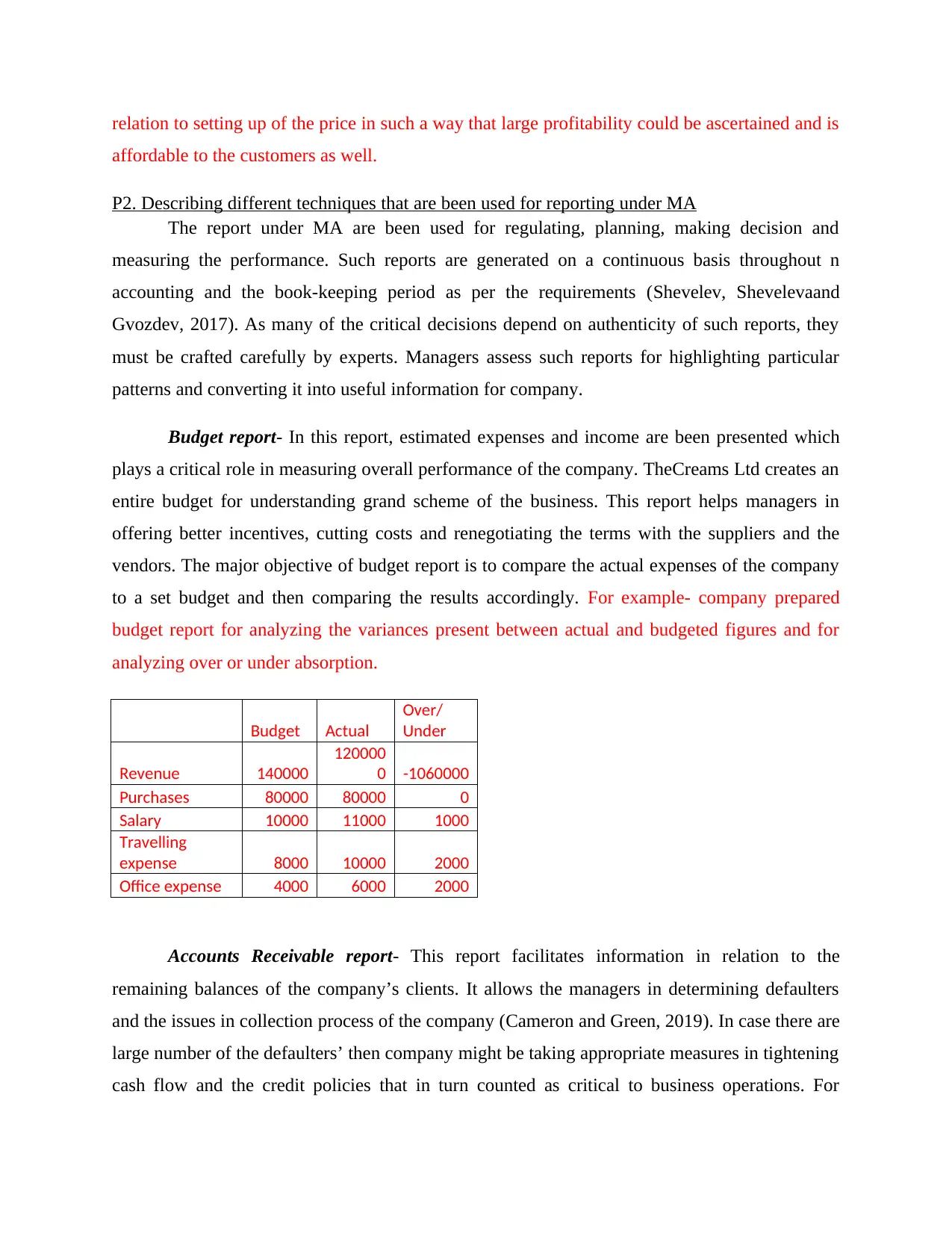
relation to setting up of the price in such a way that large profitability could be ascertained and is
affordable to the customers as well.
P2. Describing different techniques that are been used for reporting under MA
The report under MA are been used for regulating, planning, making decision and
measuring the performance. Such reports are generated on a continuous basis throughout n
accounting and the book-keeping period as per the requirements (Shevelev, Shevelevaand
Gvozdev, 2017). As many of the critical decisions depend on authenticity of such reports, they
must be crafted carefully by experts. Managers assess such reports for highlighting particular
patterns and converting it into useful information for company.
Budget report- In this report, estimated expenses and income are been presented which
plays a critical role in measuring overall performance of the company. TheCreams Ltd creates an
entire budget for understanding grand scheme of the business. This report helps managers in
offering better incentives, cutting costs and renegotiating the terms with the suppliers and the
vendors. The major objective of budget report is to compare the actual expenses of the company
to a set budget and then comparing the results accordingly. For example- company prepared
budget report for analyzing the variances present between actual and budgeted figures and for
analyzing over or under absorption.
Budget Actual
Over/
Under
Revenue 140000
120000
0 -1060000
Purchases 80000 80000 0
Salary 10000 11000 1000
Travelling
expense 8000 10000 2000
Office expense 4000 6000 2000
Accounts Receivable report- This report facilitates information in relation to the
remaining balances of the company’s clients. It allows the managers in determining defaulters
and the issues in collection process of the company (Cameron and Green, 2019). In case there are
large number of the defaulters’ then company might be taking appropriate measures in tightening
cash flow and the credit policies that in turn counted as critical to business operations. For
affordable to the customers as well.
P2. Describing different techniques that are been used for reporting under MA
The report under MA are been used for regulating, planning, making decision and
measuring the performance. Such reports are generated on a continuous basis throughout n
accounting and the book-keeping period as per the requirements (Shevelev, Shevelevaand
Gvozdev, 2017). As many of the critical decisions depend on authenticity of such reports, they
must be crafted carefully by experts. Managers assess such reports for highlighting particular
patterns and converting it into useful information for company.
Budget report- In this report, estimated expenses and income are been presented which
plays a critical role in measuring overall performance of the company. TheCreams Ltd creates an
entire budget for understanding grand scheme of the business. This report helps managers in
offering better incentives, cutting costs and renegotiating the terms with the suppliers and the
vendors. The major objective of budget report is to compare the actual expenses of the company
to a set budget and then comparing the results accordingly. For example- company prepared
budget report for analyzing the variances present between actual and budgeted figures and for
analyzing over or under absorption.
Budget Actual
Over/
Under
Revenue 140000
120000
0 -1060000
Purchases 80000 80000 0
Salary 10000 11000 1000
Travelling
expense 8000 10000 2000
Office expense 4000 6000 2000
Accounts Receivable report- This report facilitates information in relation to the
remaining balances of the company’s clients. It allows the managers in determining defaulters
and the issues in collection process of the company (Cameron and Green, 2019). In case there are
large number of the defaulters’ then company might be taking appropriate measures in tightening
cash flow and the credit policies that in turn counted as critical to business operations. For
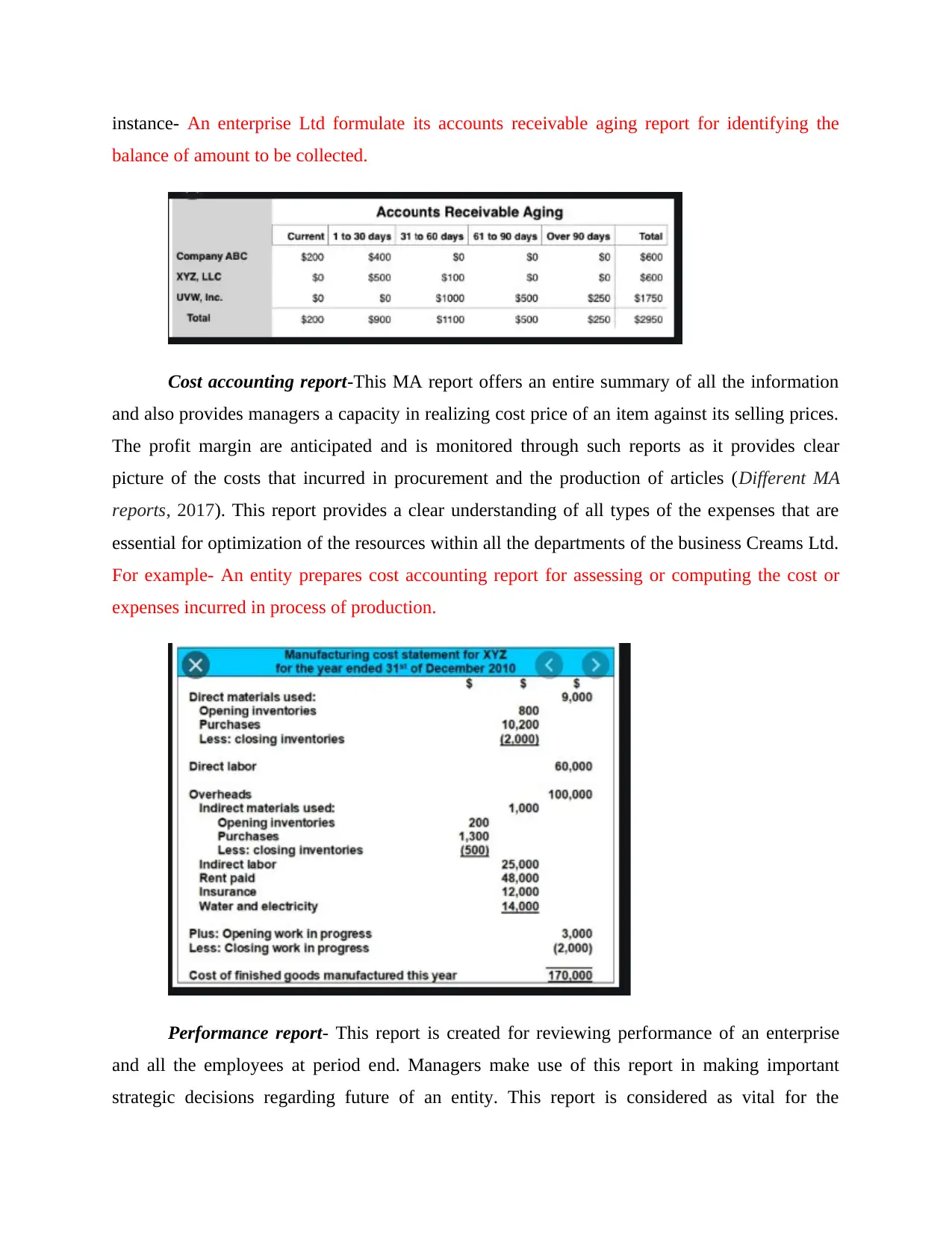
instance- An enterprise Ltd formulate its accounts receivable aging report for identifying the
balance of amount to be collected.
Cost accounting report-This MA report offers an entire summary of all the information
and also provides managers a capacity in realizing cost price of an item against its selling prices.
The profit margin are anticipated and is monitored through such reports as it provides clear
picture of the costs that incurred in procurement and the production of articles (Different MA
reports, 2017). This report provides a clear understanding of all types of the expenses that are
essential for optimization of the resources within all the departments of the business Creams Ltd.
For example- An entity prepares cost accounting report for assessing or computing the cost or
expenses incurred in process of production.
Performance report- This report is created for reviewing performance of an enterprise
and all the employees at period end. Managers make use of this report in making important
strategic decisions regarding future of an entity. This report is considered as vital for the
balance of amount to be collected.
Cost accounting report-This MA report offers an entire summary of all the information
and also provides managers a capacity in realizing cost price of an item against its selling prices.
The profit margin are anticipated and is monitored through such reports as it provides clear
picture of the costs that incurred in procurement and the production of articles (Different MA
reports, 2017). This report provides a clear understanding of all types of the expenses that are
essential for optimization of the resources within all the departments of the business Creams Ltd.
For example- An entity prepares cost accounting report for assessing or computing the cost or
expenses incurred in process of production.
Performance report- This report is created for reviewing performance of an enterprise
and all the employees at period end. Managers make use of this report in making important
strategic decisions regarding future of an entity. This report is considered as vital for the
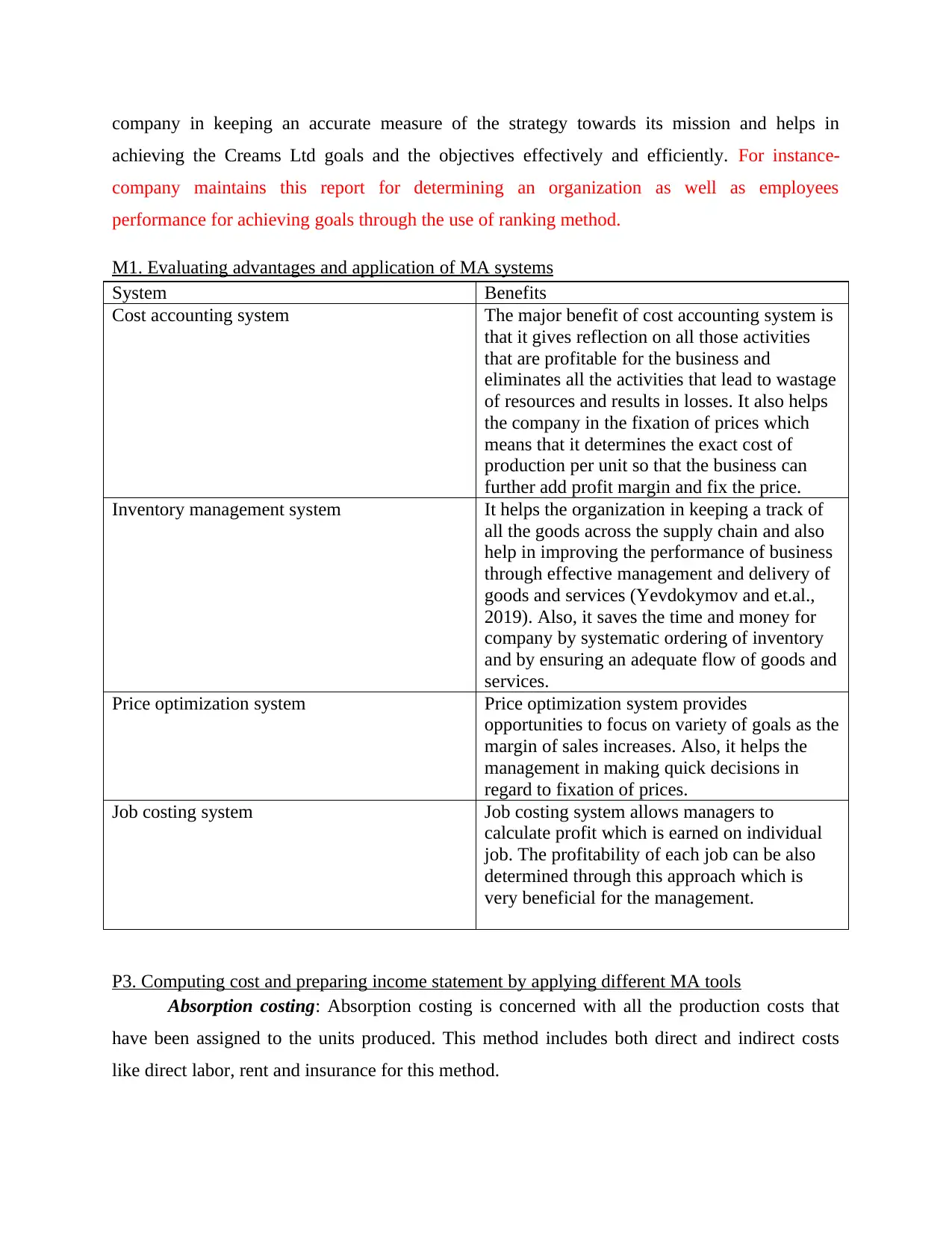
company in keeping an accurate measure of the strategy towards its mission and helps in
achieving the Creams Ltd goals and the objectives effectively and efficiently. For instance-
company maintains this report for determining an organization as well as employees
performance for achieving goals through the use of ranking method.
M1. Evaluating advantages and application of MA systems
System Benefits
Cost accounting system The major benefit of cost accounting system is
that it gives reflection on all those activities
that are profitable for the business and
eliminates all the activities that lead to wastage
of resources and results in losses. It also helps
the company in the fixation of prices which
means that it determines the exact cost of
production per unit so that the business can
further add profit margin and fix the price.
Inventory management system It helps the organization in keeping a track of
all the goods across the supply chain and also
help in improving the performance of business
through effective management and delivery of
goods and services (Yevdokymov and et.al.,
2019). Also, it saves the time and money for
company by systematic ordering of inventory
and by ensuring an adequate flow of goods and
services.
Price optimization system Price optimization system provides
opportunities to focus on variety of goals as the
margin of sales increases. Also, it helps the
management in making quick decisions in
regard to fixation of prices.
Job costing system Job costing system allows managers to
calculate profit which is earned on individual
job. The profitability of each job can be also
determined through this approach which is
very beneficial for the management.
P3. Computing cost and preparing income statement by applying different MA tools
Absorption costing: Absorption costing is concerned with all the production costs that
have been assigned to the units produced. This method includes both direct and indirect costs
like direct labor, rent and insurance for this method.
achieving the Creams Ltd goals and the objectives effectively and efficiently. For instance-
company maintains this report for determining an organization as well as employees
performance for achieving goals through the use of ranking method.
M1. Evaluating advantages and application of MA systems
System Benefits
Cost accounting system The major benefit of cost accounting system is
that it gives reflection on all those activities
that are profitable for the business and
eliminates all the activities that lead to wastage
of resources and results in losses. It also helps
the company in the fixation of prices which
means that it determines the exact cost of
production per unit so that the business can
further add profit margin and fix the price.
Inventory management system It helps the organization in keeping a track of
all the goods across the supply chain and also
help in improving the performance of business
through effective management and delivery of
goods and services (Yevdokymov and et.al.,
2019). Also, it saves the time and money for
company by systematic ordering of inventory
and by ensuring an adequate flow of goods and
services.
Price optimization system Price optimization system provides
opportunities to focus on variety of goals as the
margin of sales increases. Also, it helps the
management in making quick decisions in
regard to fixation of prices.
Job costing system Job costing system allows managers to
calculate profit which is earned on individual
job. The profitability of each job can be also
determined through this approach which is
very beneficial for the management.
P3. Computing cost and preparing income statement by applying different MA tools
Absorption costing: Absorption costing is concerned with all the production costs that
have been assigned to the units produced. This method includes both direct and indirect costs
like direct labor, rent and insurance for this method.
Paraphrase This Document
Need a fresh take? Get an instant paraphrase of this document with our AI Paraphraser
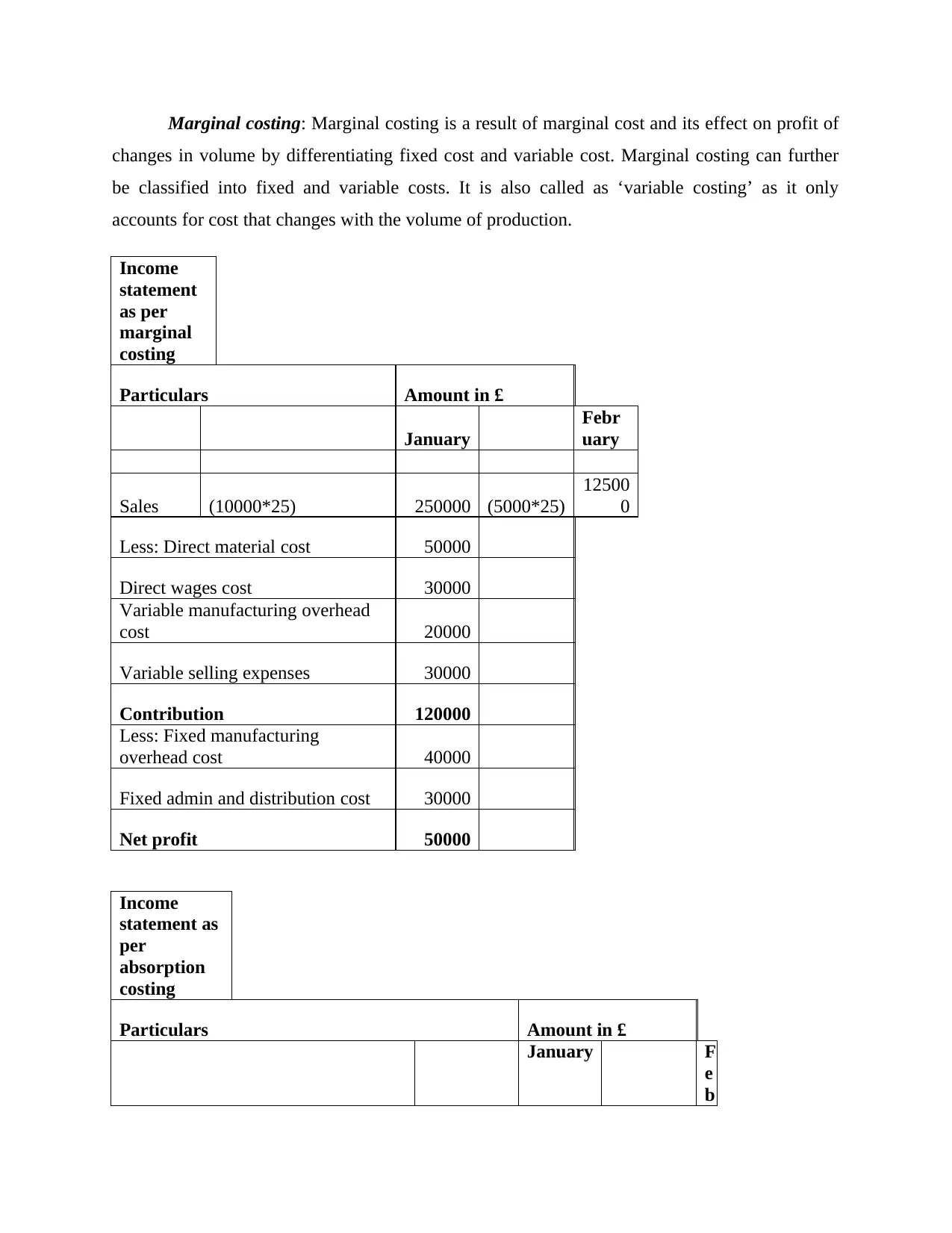
Marginal costing: Marginal costing is a result of marginal cost and its effect on profit of
changes in volume by differentiating fixed cost and variable cost. Marginal costing can further
be classified into fixed and variable costs. It is also called as ‘variable costing’ as it only
accounts for cost that changes with the volume of production.
Income
statement
as per
marginal
costing
Particulars Amount in £
January
Febr
uary
Sales (10000*25) 250000 (5000*25)
12500
0
Less: Direct material cost 50000
Direct wages cost 30000
Variable manufacturing overhead
cost 20000
Variable selling expenses 30000
Contribution 120000
Less: Fixed manufacturing
overhead cost 40000
Fixed admin and distribution cost 30000
Net profit 50000
Income
statement as
per
absorption
costing
Particulars Amount in £
January F
e
b
changes in volume by differentiating fixed cost and variable cost. Marginal costing can further
be classified into fixed and variable costs. It is also called as ‘variable costing’ as it only
accounts for cost that changes with the volume of production.
Income
statement
as per
marginal
costing
Particulars Amount in £
January
Febr
uary
Sales (10000*25) 250000 (5000*25)
12500
0
Less: Direct material cost 50000
Direct wages cost 30000
Variable manufacturing overhead
cost 20000
Variable selling expenses 30000
Contribution 120000
Less: Fixed manufacturing
overhead cost 40000
Fixed admin and distribution cost 30000
Net profit 50000
Income
statement as
per
absorption
costing
Particulars Amount in £
January F
e
b
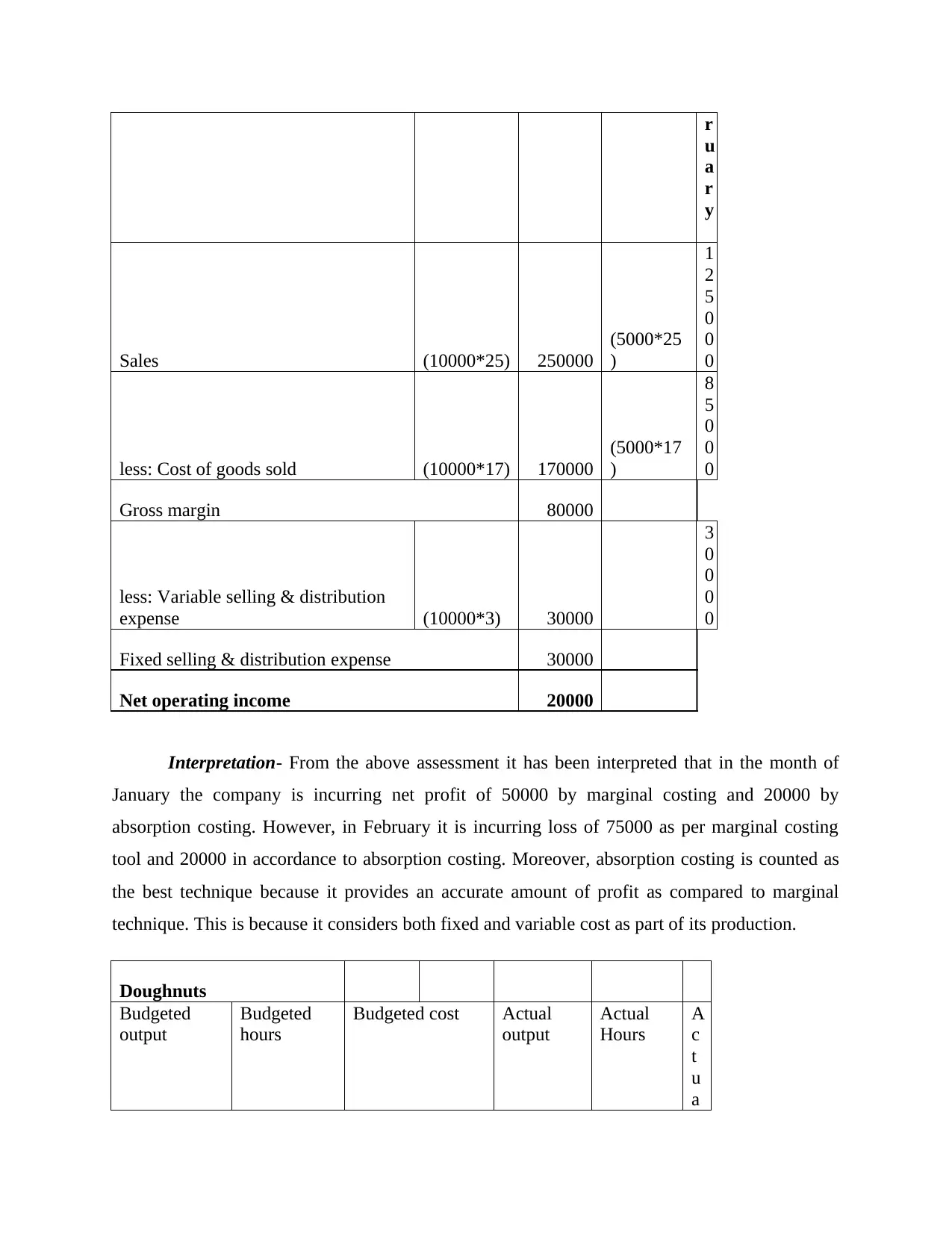
r
u
a
r
y
Sales (10000*25) 250000
(5000*25
)
1
2
5
0
0
0
less: Cost of goods sold (10000*17) 170000
(5000*17
)
8
5
0
0
0
Gross margin 80000
less: Variable selling & distribution
expense (10000*3) 30000
3
0
0
0
0
Fixed selling & distribution expense 30000
Net operating income 20000
Interpretation- From the above assessment it has been interpreted that in the month of
January the company is incurring net profit of 50000 by marginal costing and 20000 by
absorption costing. However, in February it is incurring loss of 75000 as per marginal costing
tool and 20000 in accordance to absorption costing. Moreover, absorption costing is counted as
the best technique because it provides an accurate amount of profit as compared to marginal
technique. This is because it considers both fixed and variable cost as part of its production.
Doughnuts
Budgeted
output
Budgeted
hours
Budgeted cost Actual
output
Actual
Hours
A
c
t
u
a
u
a
r
y
Sales (10000*25) 250000
(5000*25
)
1
2
5
0
0
0
less: Cost of goods sold (10000*17) 170000
(5000*17
)
8
5
0
0
0
Gross margin 80000
less: Variable selling & distribution
expense (10000*3) 30000
3
0
0
0
0
Fixed selling & distribution expense 30000
Net operating income 20000
Interpretation- From the above assessment it has been interpreted that in the month of
January the company is incurring net profit of 50000 by marginal costing and 20000 by
absorption costing. However, in February it is incurring loss of 75000 as per marginal costing
tool and 20000 in accordance to absorption costing. Moreover, absorption costing is counted as
the best technique because it provides an accurate amount of profit as compared to marginal
technique. This is because it considers both fixed and variable cost as part of its production.
Doughnuts
Budgeted
output
Budgeted
hours
Budgeted cost Actual
output
Actual
Hours
A
c
t
u
a
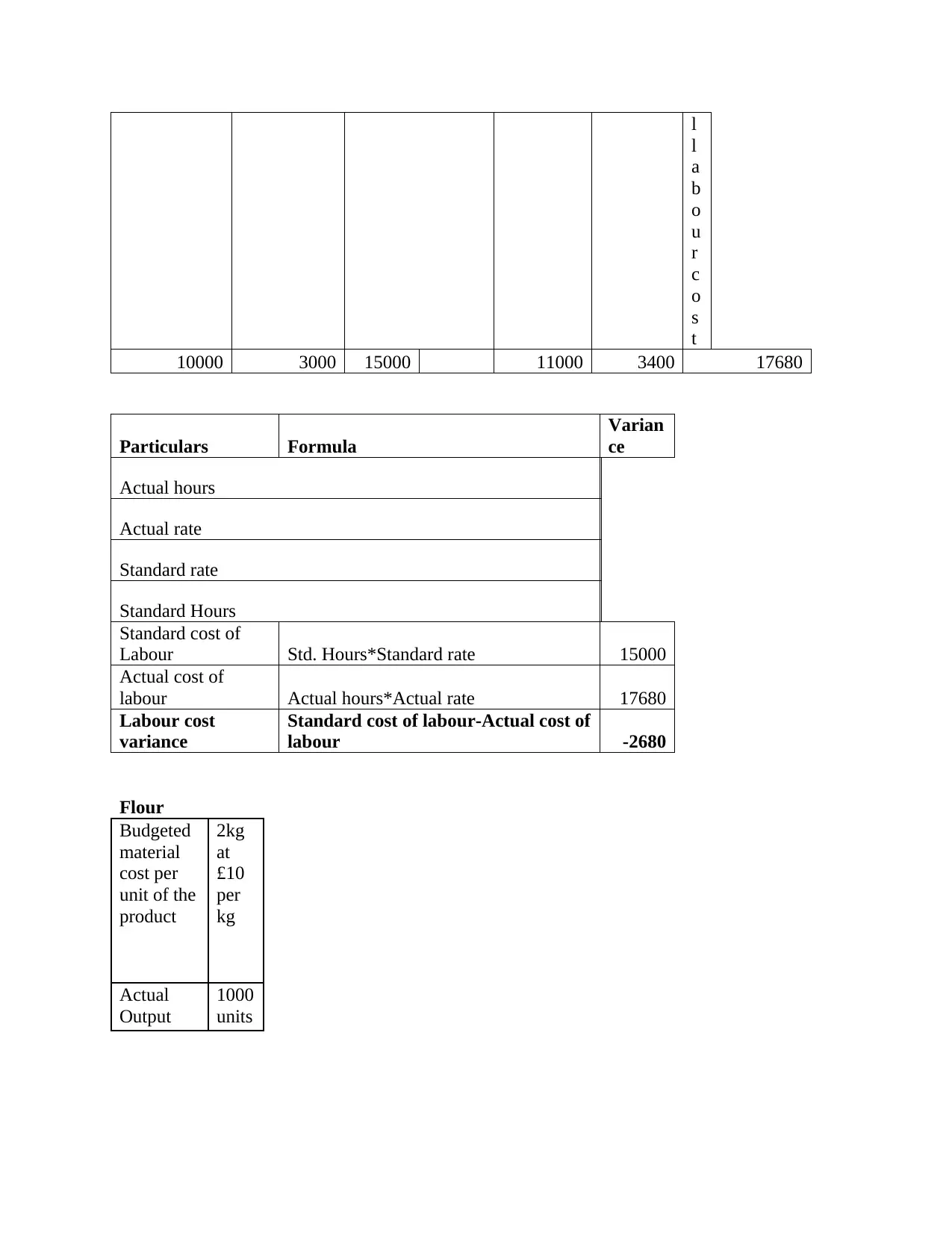
l
l
a
b
o
u
r
c
o
s
t
10000 3000 15000 11000 3400 17680
Particulars Formula
Varian
ce
Actual hours
Actual rate
Standard rate
Standard Hours
Standard cost of
Labour Std. Hours*Standard rate 15000
Actual cost of
labour Actual hours*Actual rate 17680
Labour cost
variance
Standard cost of labour-Actual cost of
labour -2680
Flour
Budgeted
material
cost per
unit of the
product
2kg
at
£10
per
kg
Actual
Output
1000
units
l
a
b
o
u
r
c
o
s
t
10000 3000 15000 11000 3400 17680
Particulars Formula
Varian
ce
Actual hours
Actual rate
Standard rate
Standard Hours
Standard cost of
Labour Std. Hours*Standard rate 15000
Actual cost of
labour Actual hours*Actual rate 17680
Labour cost
variance
Standard cost of labour-Actual cost of
labour -2680
Flour
Budgeted
material
cost per
unit of the
product
2kg
at
£10
per
kg
Actual
Output
1000
units
Secure Best Marks with AI Grader
Need help grading? Try our AI Grader for instant feedback on your assignments.
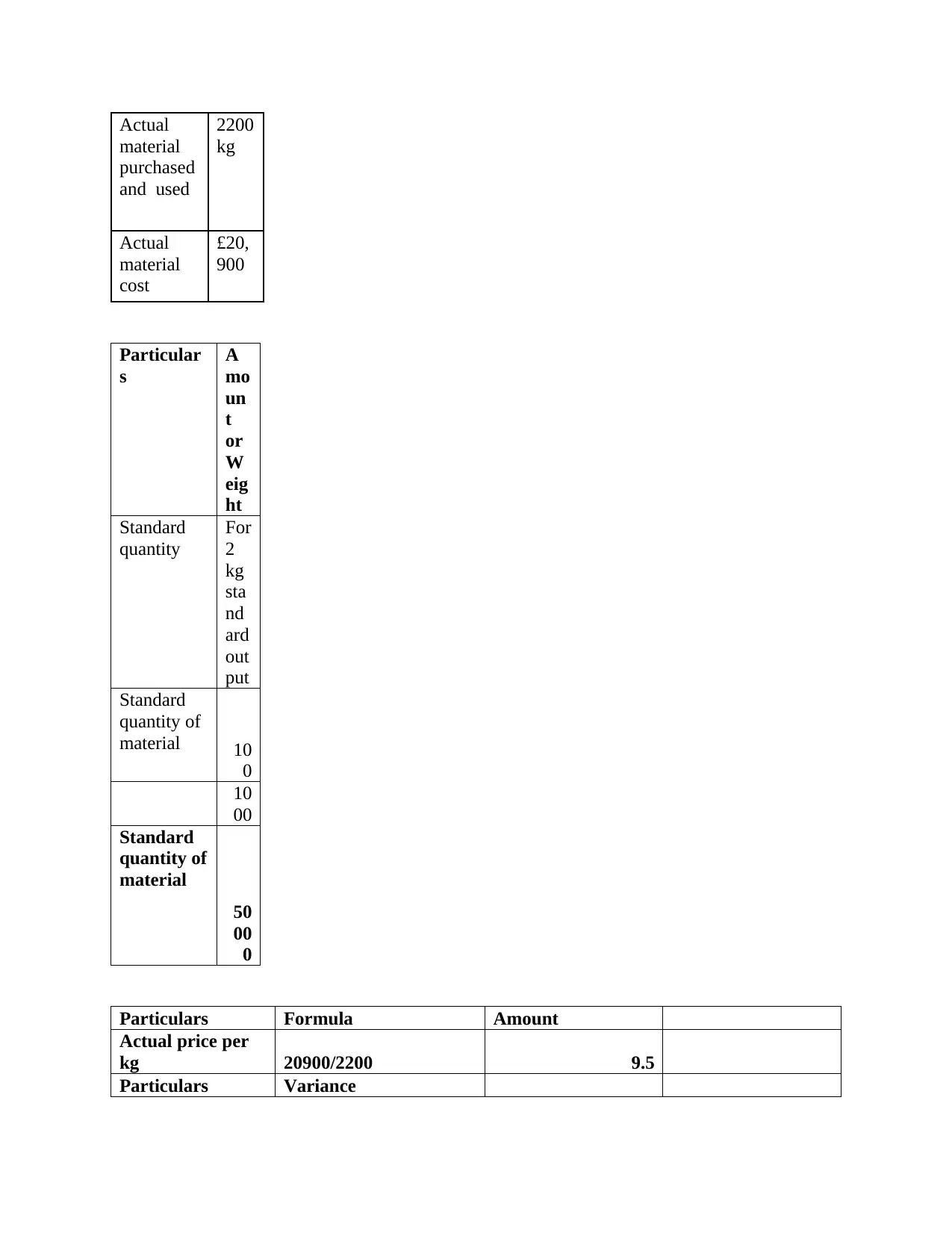
Actual
material
purchased
and used
2200
kg
Actual
material
cost
£20,
900
Particular
s
A
mo
un
t
or
W
eig
ht
Standard
quantity
For
2
kg
sta
nd
ard
out
put
Standard
quantity of
material 10
0
10
00
Standard
quantity of
material
50
00
0
Particulars Formula Amount
Actual price per
kg 20900/2200 9.5
Particulars Variance
material
purchased
and used
2200
kg
Actual
material
cost
£20,
900
Particular
s
A
mo
un
t
or
W
eig
ht
Standard
quantity
For
2
kg
sta
nd
ard
out
put
Standard
quantity of
material 10
0
10
00
Standard
quantity of
material
50
00
0
Particulars Formula Amount
Actual price per
kg 20900/2200 9.5
Particulars Variance
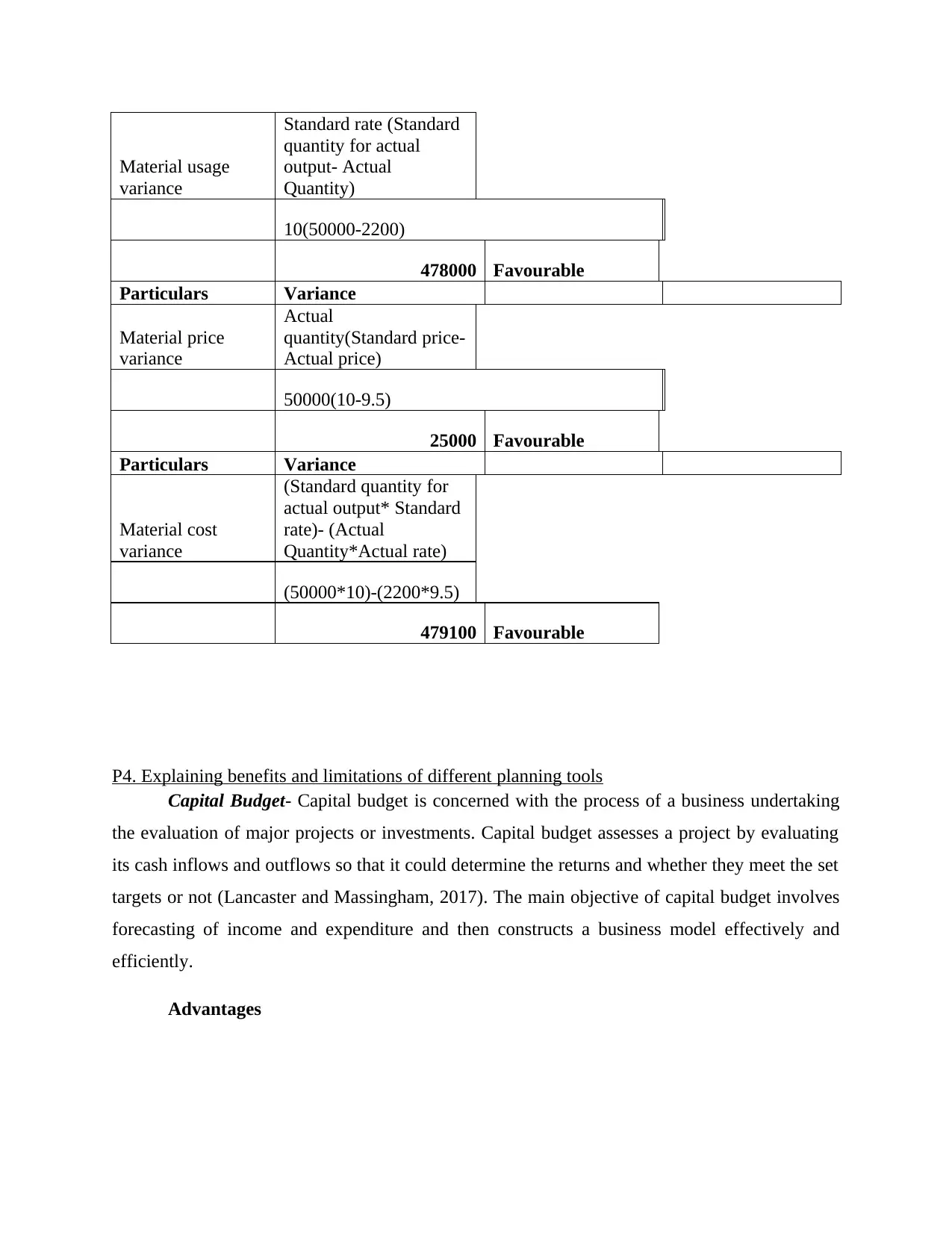
Material usage
variance
Standard rate (Standard
quantity for actual
output- Actual
Quantity)
10(50000-2200)
478000 Favourable
Particulars Variance
Material price
variance
Actual
quantity(Standard price-
Actual price)
50000(10-9.5)
25000 Favourable
Particulars Variance
Material cost
variance
(Standard quantity for
actual output* Standard
rate)- (Actual
Quantity*Actual rate)
(50000*10)-(2200*9.5)
479100 Favourable
P4. Explaining benefits and limitations of different planning tools
Capital Budget- Capital budget is concerned with the process of a business undertaking
the evaluation of major projects or investments. Capital budget assesses a project by evaluating
its cash inflows and outflows so that it could determine the returns and whether they meet the set
targets or not (Lancaster and Massingham, 2017). The main objective of capital budget involves
forecasting of income and expenditure and then constructs a business model effectively and
efficiently.
Advantages
variance
Standard rate (Standard
quantity for actual
output- Actual
Quantity)
10(50000-2200)
478000 Favourable
Particulars Variance
Material price
variance
Actual
quantity(Standard price-
Actual price)
50000(10-9.5)
25000 Favourable
Particulars Variance
Material cost
variance
(Standard quantity for
actual output* Standard
rate)- (Actual
Quantity*Actual rate)
(50000*10)-(2200*9.5)
479100 Favourable
P4. Explaining benefits and limitations of different planning tools
Capital Budget- Capital budget is concerned with the process of a business undertaking
the evaluation of major projects or investments. Capital budget assesses a project by evaluating
its cash inflows and outflows so that it could determine the returns and whether they meet the set
targets or not (Lancaster and Massingham, 2017). The main objective of capital budget involves
forecasting of income and expenditure and then constructs a business model effectively and
efficiently.
Advantages
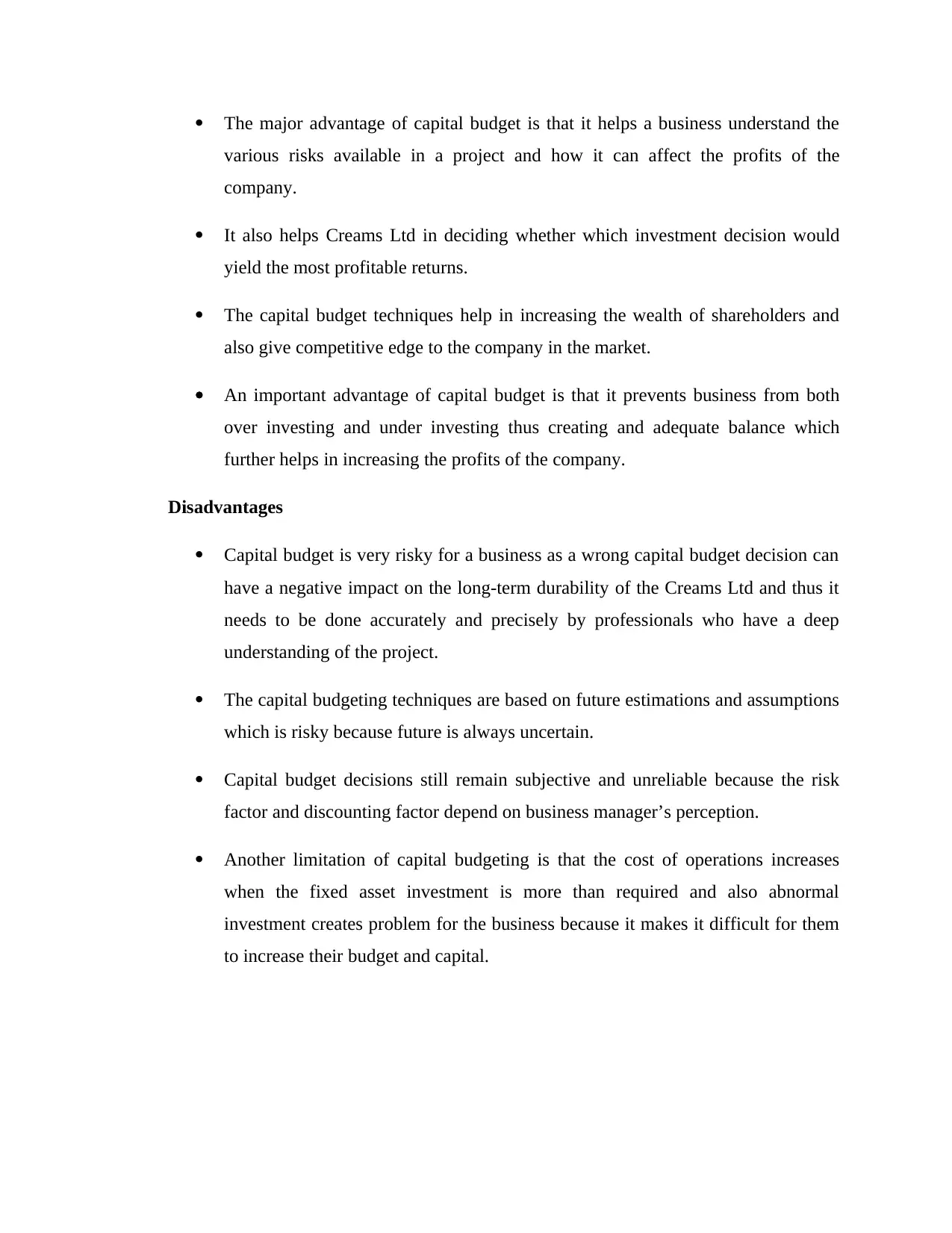
The major advantage of capital budget is that it helps a business understand the
various risks available in a project and how it can affect the profits of the
company.
It also helps Creams Ltd in deciding whether which investment decision would
yield the most profitable returns.
The capital budget techniques help in increasing the wealth of shareholders and
also give competitive edge to the company in the market.
An important advantage of capital budget is that it prevents business from both
over investing and under investing thus creating and adequate balance which
further helps in increasing the profits of the company.
Disadvantages
Capital budget is very risky for a business as a wrong capital budget decision can
have a negative impact on the long-term durability of the Creams Ltd and thus it
needs to be done accurately and precisely by professionals who have a deep
understanding of the project.
The capital budgeting techniques are based on future estimations and assumptions
which is risky because future is always uncertain.
Capital budget decisions still remain subjective and unreliable because the risk
factor and discounting factor depend on business manager’s perception.
Another limitation of capital budgeting is that the cost of operations increases
when the fixed asset investment is more than required and also abnormal
investment creates problem for the business because it makes it difficult for them
to increase their budget and capital.
various risks available in a project and how it can affect the profits of the
company.
It also helps Creams Ltd in deciding whether which investment decision would
yield the most profitable returns.
The capital budget techniques help in increasing the wealth of shareholders and
also give competitive edge to the company in the market.
An important advantage of capital budget is that it prevents business from both
over investing and under investing thus creating and adequate balance which
further helps in increasing the profits of the company.
Disadvantages
Capital budget is very risky for a business as a wrong capital budget decision can
have a negative impact on the long-term durability of the Creams Ltd and thus it
needs to be done accurately and precisely by professionals who have a deep
understanding of the project.
The capital budgeting techniques are based on future estimations and assumptions
which is risky because future is always uncertain.
Capital budget decisions still remain subjective and unreliable because the risk
factor and discounting factor depend on business manager’s perception.
Another limitation of capital budgeting is that the cost of operations increases
when the fixed asset investment is more than required and also abnormal
investment creates problem for the business because it makes it difficult for them
to increase their budget and capital.
Paraphrase This Document
Need a fresh take? Get an instant paraphrase of this document with our AI Paraphraser
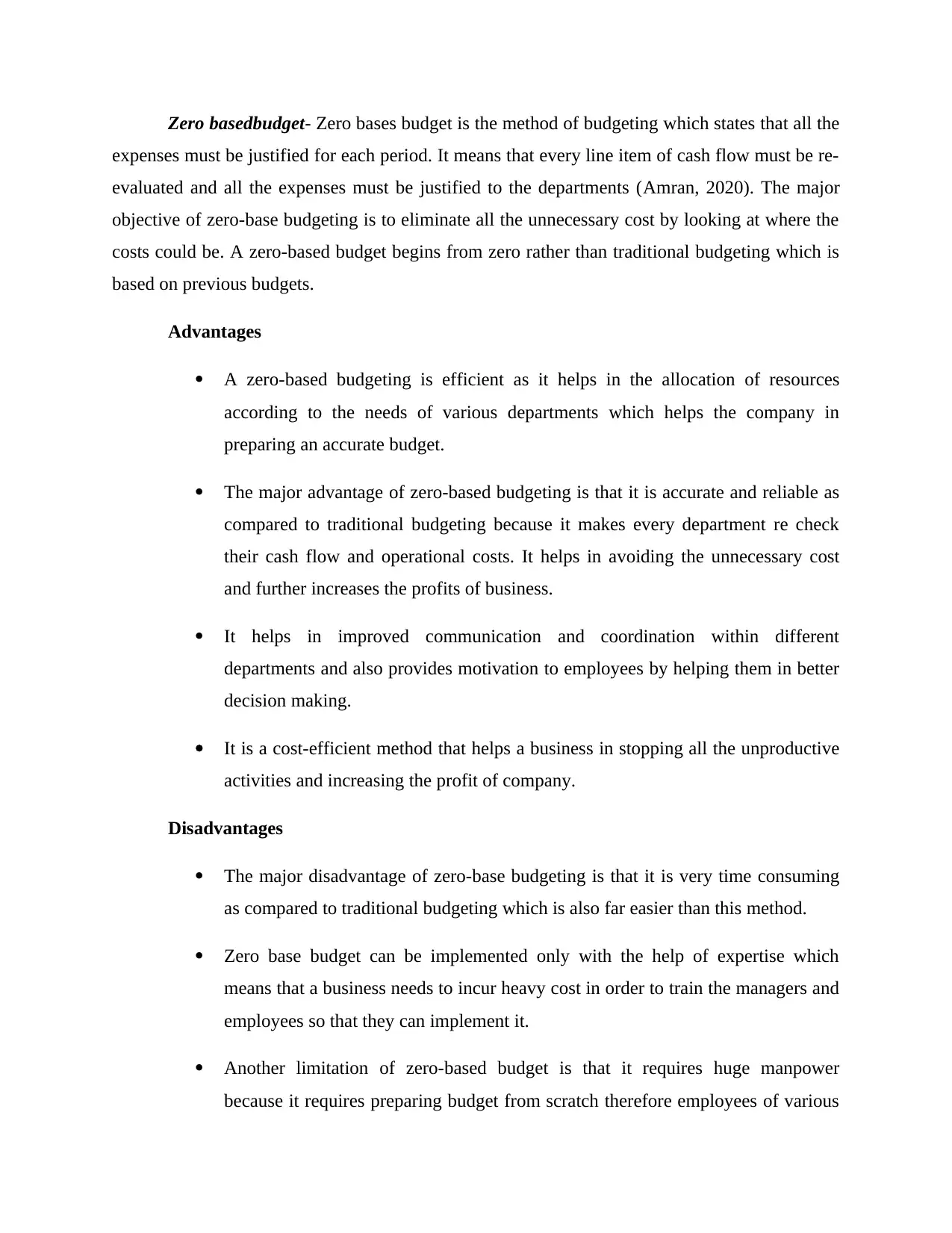
Zero basedbudget- Zero bases budget is the method of budgeting which states that all the
expenses must be justified for each period. It means that every line item of cash flow must be re-
evaluated and all the expenses must be justified to the departments (Amran, 2020). The major
objective of zero-base budgeting is to eliminate all the unnecessary cost by looking at where the
costs could be. A zero-based budget begins from zero rather than traditional budgeting which is
based on previous budgets.
Advantages
A zero-based budgeting is efficient as it helps in the allocation of resources
according to the needs of various departments which helps the company in
preparing an accurate budget.
The major advantage of zero-based budgeting is that it is accurate and reliable as
compared to traditional budgeting because it makes every department re check
their cash flow and operational costs. It helps in avoiding the unnecessary cost
and further increases the profits of business.
It helps in improved communication and coordination within different
departments and also provides motivation to employees by helping them in better
decision making.
It is a cost-efficient method that helps a business in stopping all the unproductive
activities and increasing the profit of company.
Disadvantages
The major disadvantage of zero-base budgeting is that it is very time consuming
as compared to traditional budgeting which is also far easier than this method.
Zero base budget can be implemented only with the help of expertise which
means that a business needs to incur heavy cost in order to train the managers and
employees so that they can implement it.
Another limitation of zero-based budget is that it requires huge manpower
because it requires preparing budget from scratch therefore employees of various
expenses must be justified for each period. It means that every line item of cash flow must be re-
evaluated and all the expenses must be justified to the departments (Amran, 2020). The major
objective of zero-base budgeting is to eliminate all the unnecessary cost by looking at where the
costs could be. A zero-based budget begins from zero rather than traditional budgeting which is
based on previous budgets.
Advantages
A zero-based budgeting is efficient as it helps in the allocation of resources
according to the needs of various departments which helps the company in
preparing an accurate budget.
The major advantage of zero-based budgeting is that it is accurate and reliable as
compared to traditional budgeting because it makes every department re check
their cash flow and operational costs. It helps in avoiding the unnecessary cost
and further increases the profits of business.
It helps in improved communication and coordination within different
departments and also provides motivation to employees by helping them in better
decision making.
It is a cost-efficient method that helps a business in stopping all the unproductive
activities and increasing the profit of company.
Disadvantages
The major disadvantage of zero-base budgeting is that it is very time consuming
as compared to traditional budgeting which is also far easier than this method.
Zero base budget can be implemented only with the help of expertise which
means that a business needs to incur heavy cost in order to train the managers and
employees so that they can implement it.
Another limitation of zero-based budget is that it requires huge manpower
because it requires preparing budget from scratch therefore employees of various
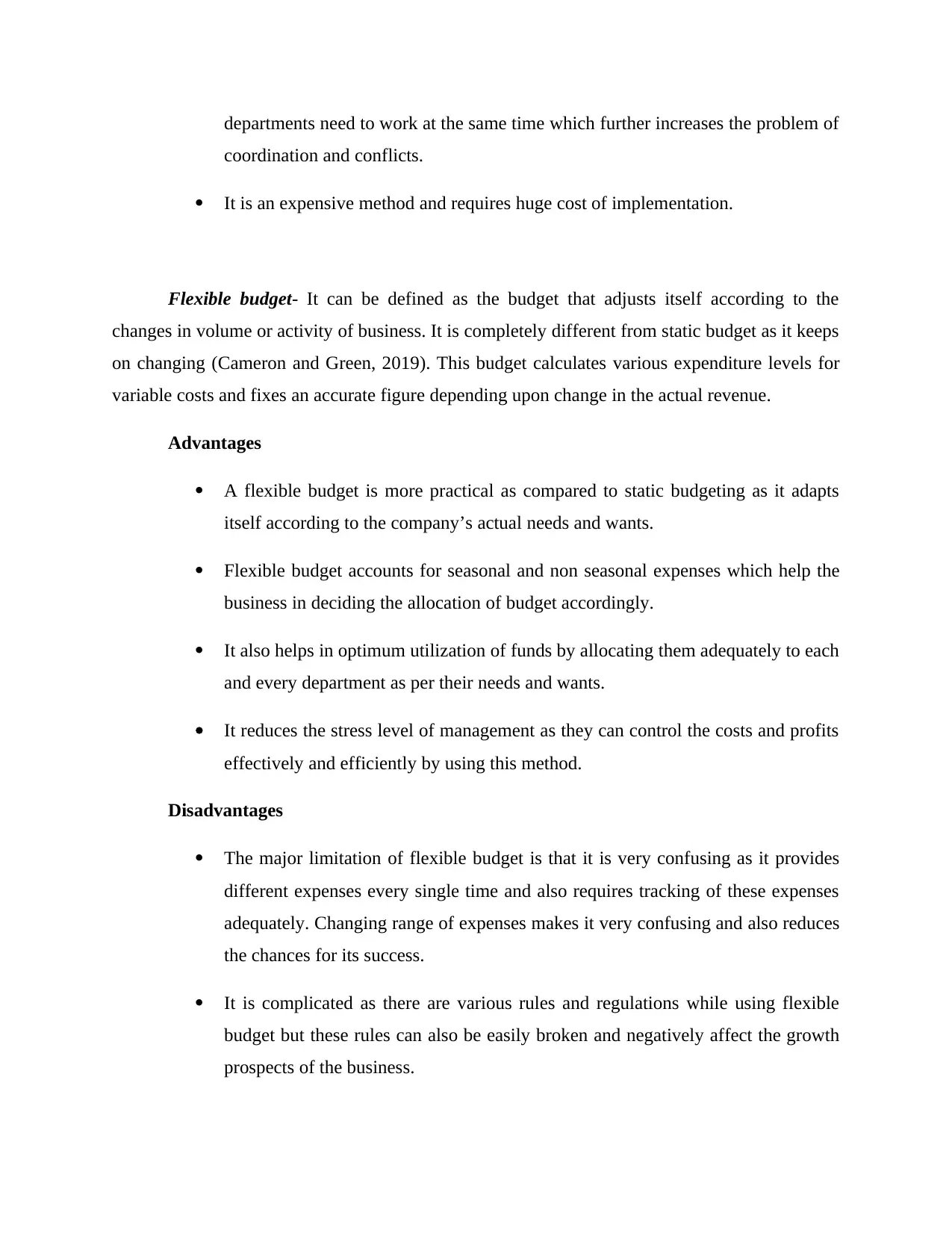
departments need to work at the same time which further increases the problem of
coordination and conflicts.
It is an expensive method and requires huge cost of implementation.
Flexible budget- It can be defined as the budget that adjusts itself according to the
changes in volume or activity of business. It is completely different from static budget as it keeps
on changing (Cameron and Green, 2019). This budget calculates various expenditure levels for
variable costs and fixes an accurate figure depending upon change in the actual revenue.
Advantages
A flexible budget is more practical as compared to static budgeting as it adapts
itself according to the company’s actual needs and wants.
Flexible budget accounts for seasonal and non seasonal expenses which help the
business in deciding the allocation of budget accordingly.
It also helps in optimum utilization of funds by allocating them adequately to each
and every department as per their needs and wants.
It reduces the stress level of management as they can control the costs and profits
effectively and efficiently by using this method.
Disadvantages
The major limitation of flexible budget is that it is very confusing as it provides
different expenses every single time and also requires tracking of these expenses
adequately. Changing range of expenses makes it very confusing and also reduces
the chances for its success.
It is complicated as there are various rules and regulations while using flexible
budget but these rules can also be easily broken and negatively affect the growth
prospects of the business.
coordination and conflicts.
It is an expensive method and requires huge cost of implementation.
Flexible budget- It can be defined as the budget that adjusts itself according to the
changes in volume or activity of business. It is completely different from static budget as it keeps
on changing (Cameron and Green, 2019). This budget calculates various expenditure levels for
variable costs and fixes an accurate figure depending upon change in the actual revenue.
Advantages
A flexible budget is more practical as compared to static budgeting as it adapts
itself according to the company’s actual needs and wants.
Flexible budget accounts for seasonal and non seasonal expenses which help the
business in deciding the allocation of budget accordingly.
It also helps in optimum utilization of funds by allocating them adequately to each
and every department as per their needs and wants.
It reduces the stress level of management as they can control the costs and profits
effectively and efficiently by using this method.
Disadvantages
The major limitation of flexible budget is that it is very confusing as it provides
different expenses every single time and also requires tracking of these expenses
adequately. Changing range of expenses makes it very confusing and also reduces
the chances for its success.
It is complicated as there are various rules and regulations while using flexible
budget but these rules can also be easily broken and negatively affect the growth
prospects of the business.
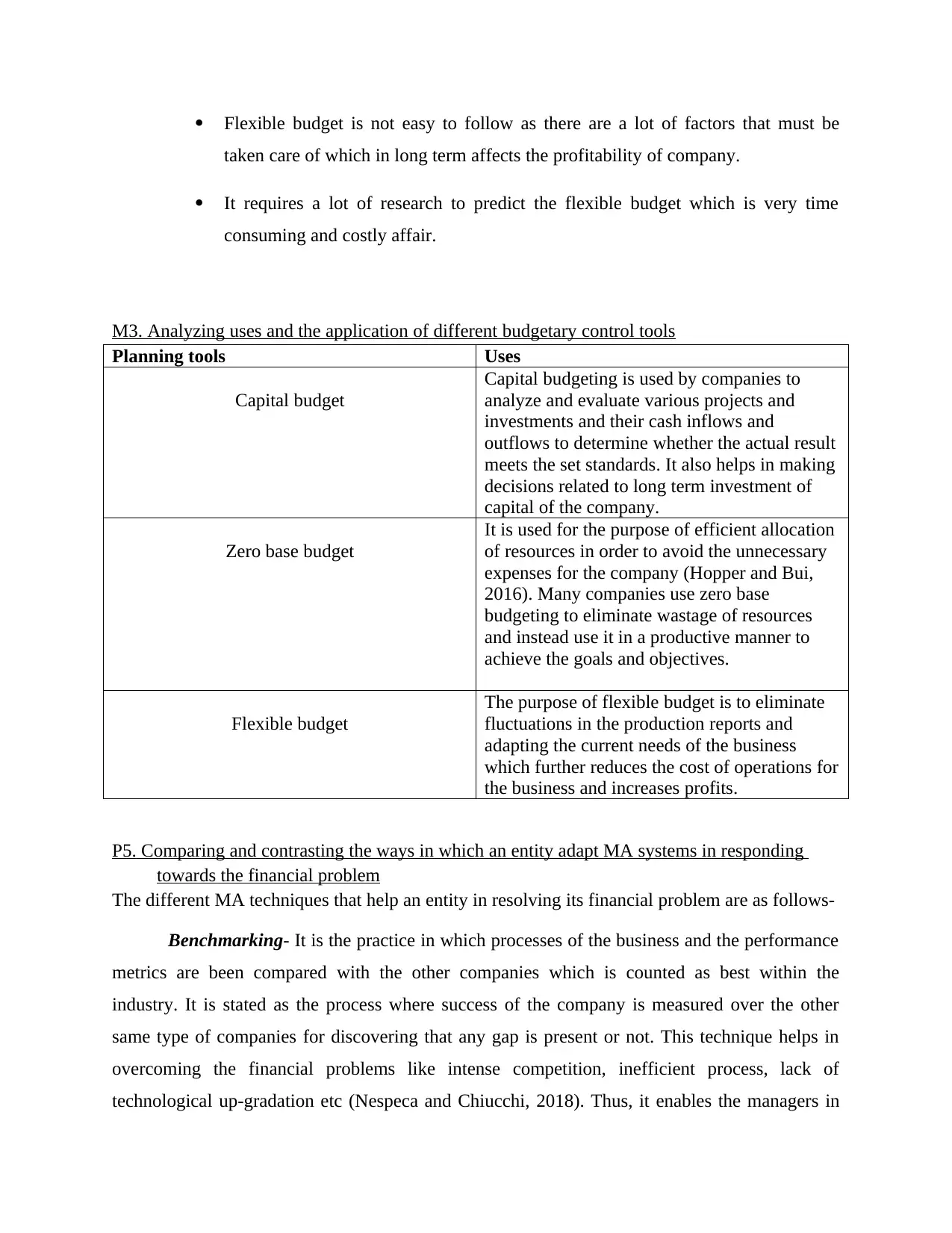
Flexible budget is not easy to follow as there are a lot of factors that must be
taken care of which in long term affects the profitability of company.
It requires a lot of research to predict the flexible budget which is very time
consuming and costly affair.
M3. Analyzing uses and the application of different budgetary control tools
Planning tools Uses
Capital budget
Capital budgeting is used by companies to
analyze and evaluate various projects and
investments and their cash inflows and
outflows to determine whether the actual result
meets the set standards. It also helps in making
decisions related to long term investment of
capital of the company.
Zero base budget
It is used for the purpose of efficient allocation
of resources in order to avoid the unnecessary
expenses for the company (Hopper and Bui,
2016). Many companies use zero base
budgeting to eliminate wastage of resources
and instead use it in a productive manner to
achieve the goals and objectives.
Flexible budget
The purpose of flexible budget is to eliminate
fluctuations in the production reports and
adapting the current needs of the business
which further reduces the cost of operations for
the business and increases profits.
P5. Comparing and contrasting the ways in which an entity adapt MA systems in responding
towards the financial problem
The different MA techniques that help an entity in resolving its financial problem are as follows-
Benchmarking- It is the practice in which processes of the business and the performance
metrics are been compared with the other companies which is counted as best within the
industry. It is stated as the process where success of the company is measured over the other
same type of companies for discovering that any gap is present or not. This technique helps in
overcoming the financial problems like intense competition, inefficient process, lack of
technological up-gradation etc (Nespeca and Chiucchi, 2018). Thus, it enables the managers in
taken care of which in long term affects the profitability of company.
It requires a lot of research to predict the flexible budget which is very time
consuming and costly affair.
M3. Analyzing uses and the application of different budgetary control tools
Planning tools Uses
Capital budget
Capital budgeting is used by companies to
analyze and evaluate various projects and
investments and their cash inflows and
outflows to determine whether the actual result
meets the set standards. It also helps in making
decisions related to long term investment of
capital of the company.
Zero base budget
It is used for the purpose of efficient allocation
of resources in order to avoid the unnecessary
expenses for the company (Hopper and Bui,
2016). Many companies use zero base
budgeting to eliminate wastage of resources
and instead use it in a productive manner to
achieve the goals and objectives.
Flexible budget
The purpose of flexible budget is to eliminate
fluctuations in the production reports and
adapting the current needs of the business
which further reduces the cost of operations for
the business and increases profits.
P5. Comparing and contrasting the ways in which an entity adapt MA systems in responding
towards the financial problem
The different MA techniques that help an entity in resolving its financial problem are as follows-
Benchmarking- It is the practice in which processes of the business and the performance
metrics are been compared with the other companies which is counted as best within the
industry. It is stated as the process where success of the company is measured over the other
same type of companies for discovering that any gap is present or not. This technique helps in
overcoming the financial problems like intense competition, inefficient process, lack of
technological up-gradation etc (Nespeca and Chiucchi, 2018). Thus, it enables the managers in
Secure Best Marks with AI Grader
Need help grading? Try our AI Grader for instant feedback on your assignments.
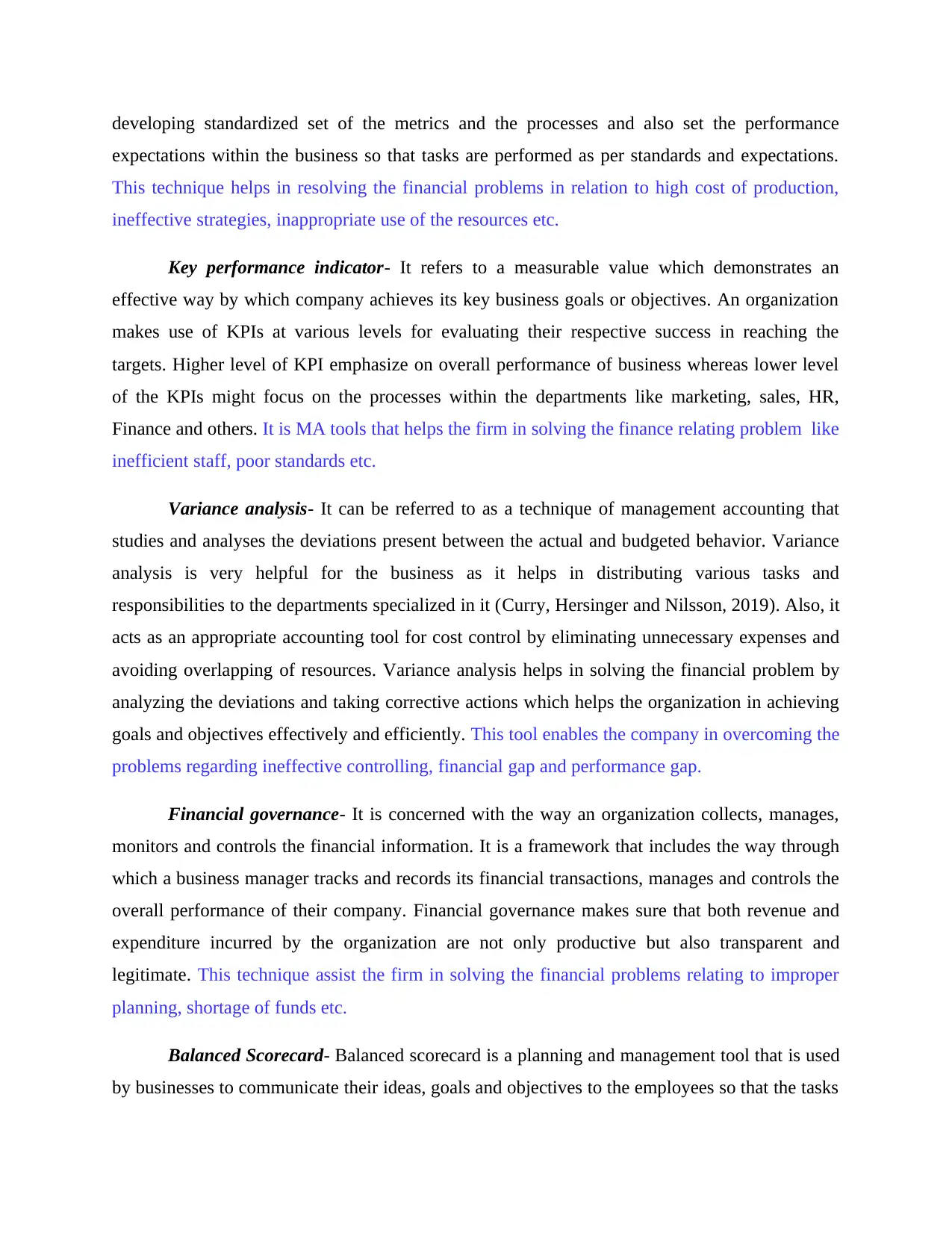
developing standardized set of the metrics and the processes and also set the performance
expectations within the business so that tasks are performed as per standards and expectations.
This technique helps in resolving the financial problems in relation to high cost of production,
ineffective strategies, inappropriate use of the resources etc.
Key performance indicator- It refers to a measurable value which demonstrates an
effective way by which company achieves its key business goals or objectives. An organization
makes use of KPIs at various levels for evaluating their respective success in reaching the
targets. Higher level of KPI emphasize on overall performance of business whereas lower level
of the KPIs might focus on the processes within the departments like marketing, sales, HR,
Finance and others. It is MA tools that helps the firm in solving the finance relating problem like
inefficient staff, poor standards etc.
Variance analysis- It can be referred to as a technique of management accounting that
studies and analyses the deviations present between the actual and budgeted behavior. Variance
analysis is very helpful for the business as it helps in distributing various tasks and
responsibilities to the departments specialized in it (Curry, Hersinger and Nilsson, 2019). Also, it
acts as an appropriate accounting tool for cost control by eliminating unnecessary expenses and
avoiding overlapping of resources. Variance analysis helps in solving the financial problem by
analyzing the deviations and taking corrective actions which helps the organization in achieving
goals and objectives effectively and efficiently. This tool enables the company in overcoming the
problems regarding ineffective controlling, financial gap and performance gap.
Financial governance- It is concerned with the way an organization collects, manages,
monitors and controls the financial information. It is a framework that includes the way through
which a business manager tracks and records its financial transactions, manages and controls the
overall performance of their company. Financial governance makes sure that both revenue and
expenditure incurred by the organization are not only productive but also transparent and
legitimate. This technique assist the firm in solving the financial problems relating to improper
planning, shortage of funds etc.
Balanced Scorecard- Balanced scorecard is a planning and management tool that is used
by businesses to communicate their ideas, goals and objectives to the employees so that the tasks
expectations within the business so that tasks are performed as per standards and expectations.
This technique helps in resolving the financial problems in relation to high cost of production,
ineffective strategies, inappropriate use of the resources etc.
Key performance indicator- It refers to a measurable value which demonstrates an
effective way by which company achieves its key business goals or objectives. An organization
makes use of KPIs at various levels for evaluating their respective success in reaching the
targets. Higher level of KPI emphasize on overall performance of business whereas lower level
of the KPIs might focus on the processes within the departments like marketing, sales, HR,
Finance and others. It is MA tools that helps the firm in solving the finance relating problem like
inefficient staff, poor standards etc.
Variance analysis- It can be referred to as a technique of management accounting that
studies and analyses the deviations present between the actual and budgeted behavior. Variance
analysis is very helpful for the business as it helps in distributing various tasks and
responsibilities to the departments specialized in it (Curry, Hersinger and Nilsson, 2019). Also, it
acts as an appropriate accounting tool for cost control by eliminating unnecessary expenses and
avoiding overlapping of resources. Variance analysis helps in solving the financial problem by
analyzing the deviations and taking corrective actions which helps the organization in achieving
goals and objectives effectively and efficiently. This tool enables the company in overcoming the
problems regarding ineffective controlling, financial gap and performance gap.
Financial governance- It is concerned with the way an organization collects, manages,
monitors and controls the financial information. It is a framework that includes the way through
which a business manager tracks and records its financial transactions, manages and controls the
overall performance of their company. Financial governance makes sure that both revenue and
expenditure incurred by the organization are not only productive but also transparent and
legitimate. This technique assist the firm in solving the financial problems relating to improper
planning, shortage of funds etc.
Balanced Scorecard- Balanced scorecard is a planning and management tool that is used
by businesses to communicate their ideas, goals and objectives to the employees so that the tasks
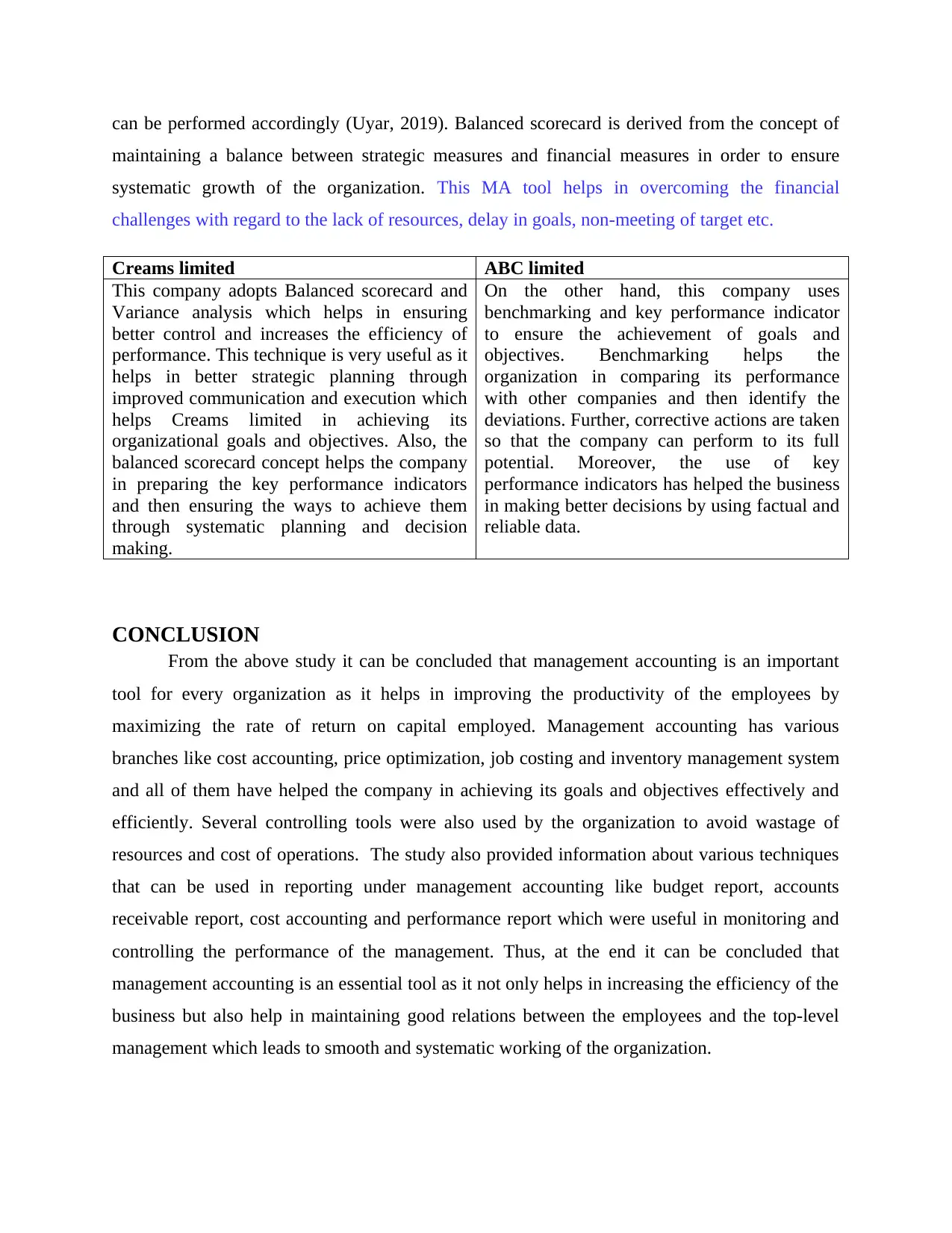
can be performed accordingly (Uyar, 2019). Balanced scorecard is derived from the concept of
maintaining a balance between strategic measures and financial measures in order to ensure
systematic growth of the organization. This MA tool helps in overcoming the financial
challenges with regard to the lack of resources, delay in goals, non-meeting of target etc.
Creams limited ABC limited
This company adopts Balanced scorecard and
Variance analysis which helps in ensuring
better control and increases the efficiency of
performance. This technique is very useful as it
helps in better strategic planning through
improved communication and execution which
helps Creams limited in achieving its
organizational goals and objectives. Also, the
balanced scorecard concept helps the company
in preparing the key performance indicators
and then ensuring the ways to achieve them
through systematic planning and decision
making.
On the other hand, this company uses
benchmarking and key performance indicator
to ensure the achievement of goals and
objectives. Benchmarking helps the
organization in comparing its performance
with other companies and then identify the
deviations. Further, corrective actions are taken
so that the company can perform to its full
potential. Moreover, the use of key
performance indicators has helped the business
in making better decisions by using factual and
reliable data.
CONCLUSION
From the above study it can be concluded that management accounting is an important
tool for every organization as it helps in improving the productivity of the employees by
maximizing the rate of return on capital employed. Management accounting has various
branches like cost accounting, price optimization, job costing and inventory management system
and all of them have helped the company in achieving its goals and objectives effectively and
efficiently. Several controlling tools were also used by the organization to avoid wastage of
resources and cost of operations. The study also provided information about various techniques
that can be used in reporting under management accounting like budget report, accounts
receivable report, cost accounting and performance report which were useful in monitoring and
controlling the performance of the management. Thus, at the end it can be concluded that
management accounting is an essential tool as it not only helps in increasing the efficiency of the
business but also help in maintaining good relations between the employees and the top-level
management which leads to smooth and systematic working of the organization.
maintaining a balance between strategic measures and financial measures in order to ensure
systematic growth of the organization. This MA tool helps in overcoming the financial
challenges with regard to the lack of resources, delay in goals, non-meeting of target etc.
Creams limited ABC limited
This company adopts Balanced scorecard and
Variance analysis which helps in ensuring
better control and increases the efficiency of
performance. This technique is very useful as it
helps in better strategic planning through
improved communication and execution which
helps Creams limited in achieving its
organizational goals and objectives. Also, the
balanced scorecard concept helps the company
in preparing the key performance indicators
and then ensuring the ways to achieve them
through systematic planning and decision
making.
On the other hand, this company uses
benchmarking and key performance indicator
to ensure the achievement of goals and
objectives. Benchmarking helps the
organization in comparing its performance
with other companies and then identify the
deviations. Further, corrective actions are taken
so that the company can perform to its full
potential. Moreover, the use of key
performance indicators has helped the business
in making better decisions by using factual and
reliable data.
CONCLUSION
From the above study it can be concluded that management accounting is an important
tool for every organization as it helps in improving the productivity of the employees by
maximizing the rate of return on capital employed. Management accounting has various
branches like cost accounting, price optimization, job costing and inventory management system
and all of them have helped the company in achieving its goals and objectives effectively and
efficiently. Several controlling tools were also used by the organization to avoid wastage of
resources and cost of operations. The study also provided information about various techniques
that can be used in reporting under management accounting like budget report, accounts
receivable report, cost accounting and performance report which were useful in monitoring and
controlling the performance of the management. Thus, at the end it can be concluded that
management accounting is an essential tool as it not only helps in increasing the efficiency of the
business but also help in maintaining good relations between the employees and the top-level
management which leads to smooth and systematic working of the organization.
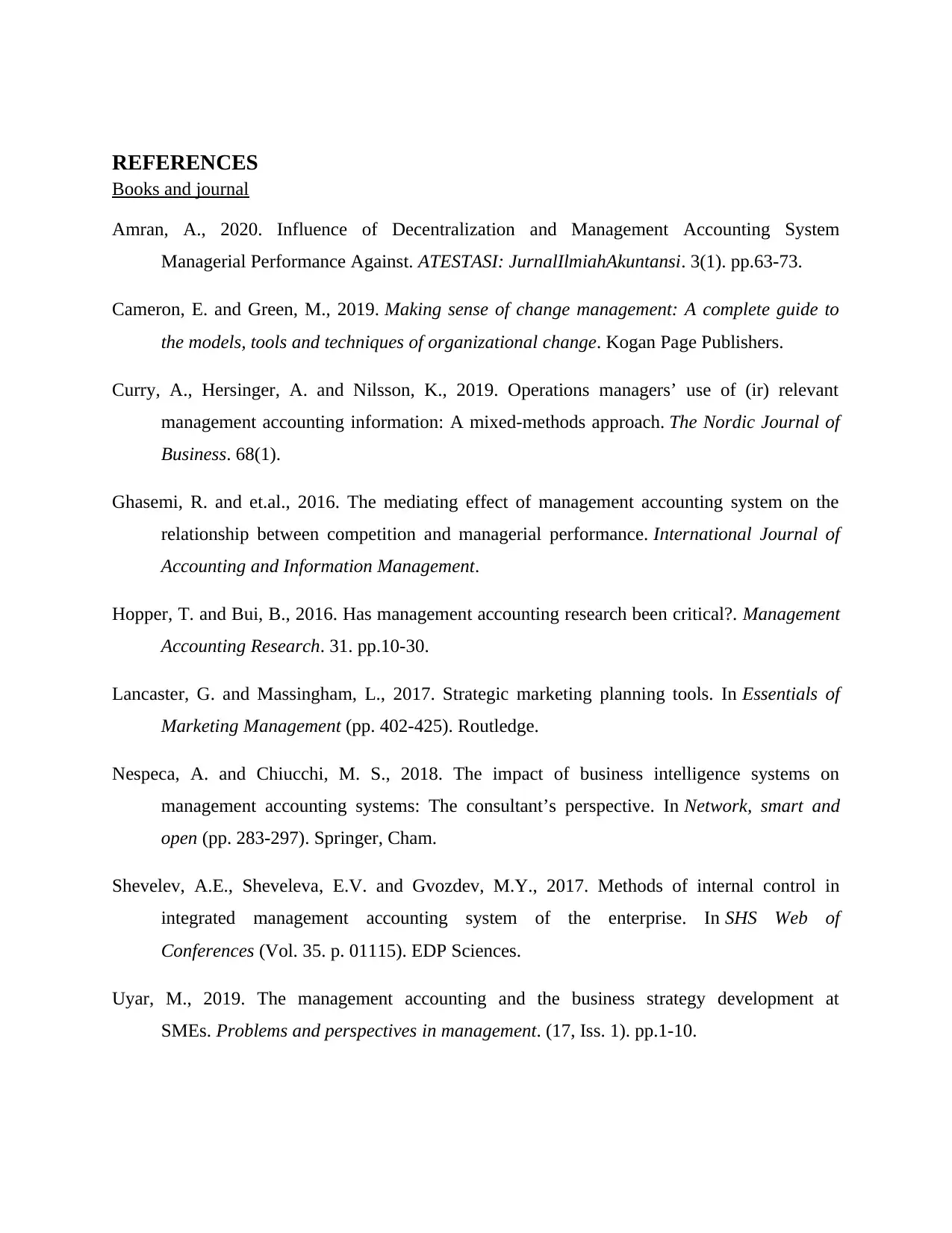
REFERENCES
Books and journal
Amran, A., 2020. Influence of Decentralization and Management Accounting System
Managerial Performance Against. ATESTASI: JurnalIlmiahAkuntansi. 3(1). pp.63-73.
Cameron, E. and Green, M., 2019. Making sense of change management: A complete guide to
the models, tools and techniques of organizational change. Kogan Page Publishers.
Curry, A., Hersinger, A. and Nilsson, K., 2019. Operations managers’ use of (ir) relevant
management accounting information: A mixed-methods approach. The Nordic Journal of
Business. 68(1).
Ghasemi, R. and et.al., 2016. The mediating effect of management accounting system on the
relationship between competition and managerial performance. International Journal of
Accounting and Information Management.
Hopper, T. and Bui, B., 2016. Has management accounting research been critical?. Management
Accounting Research. 31. pp.10-30.
Lancaster, G. and Massingham, L., 2017. Strategic marketing planning tools. In Essentials of
Marketing Management (pp. 402-425). Routledge.
Nespeca, A. and Chiucchi, M. S., 2018. The impact of business intelligence systems on
management accounting systems: The consultant’s perspective. In Network, smart and
open (pp. 283-297). Springer, Cham.
Shevelev, A.E., Sheveleva, E.V. and Gvozdev, M.Y., 2017. Methods of internal control in
integrated management accounting system of the enterprise. In SHS Web of
Conferences (Vol. 35. p. 01115). EDP Sciences.
Uyar, M., 2019. The management accounting and the business strategy development at
SMEs. Problems and perspectives in management. (17, Iss. 1). pp.1-10.
Books and journal
Amran, A., 2020. Influence of Decentralization and Management Accounting System
Managerial Performance Against. ATESTASI: JurnalIlmiahAkuntansi. 3(1). pp.63-73.
Cameron, E. and Green, M., 2019. Making sense of change management: A complete guide to
the models, tools and techniques of organizational change. Kogan Page Publishers.
Curry, A., Hersinger, A. and Nilsson, K., 2019. Operations managers’ use of (ir) relevant
management accounting information: A mixed-methods approach. The Nordic Journal of
Business. 68(1).
Ghasemi, R. and et.al., 2016. The mediating effect of management accounting system on the
relationship between competition and managerial performance. International Journal of
Accounting and Information Management.
Hopper, T. and Bui, B., 2016. Has management accounting research been critical?. Management
Accounting Research. 31. pp.10-30.
Lancaster, G. and Massingham, L., 2017. Strategic marketing planning tools. In Essentials of
Marketing Management (pp. 402-425). Routledge.
Nespeca, A. and Chiucchi, M. S., 2018. The impact of business intelligence systems on
management accounting systems: The consultant’s perspective. In Network, smart and
open (pp. 283-297). Springer, Cham.
Shevelev, A.E., Sheveleva, E.V. and Gvozdev, M.Y., 2017. Methods of internal control in
integrated management accounting system of the enterprise. In SHS Web of
Conferences (Vol. 35. p. 01115). EDP Sciences.
Uyar, M., 2019. The management accounting and the business strategy development at
SMEs. Problems and perspectives in management. (17, Iss. 1). pp.1-10.
Paraphrase This Document
Need a fresh take? Get an instant paraphrase of this document with our AI Paraphraser
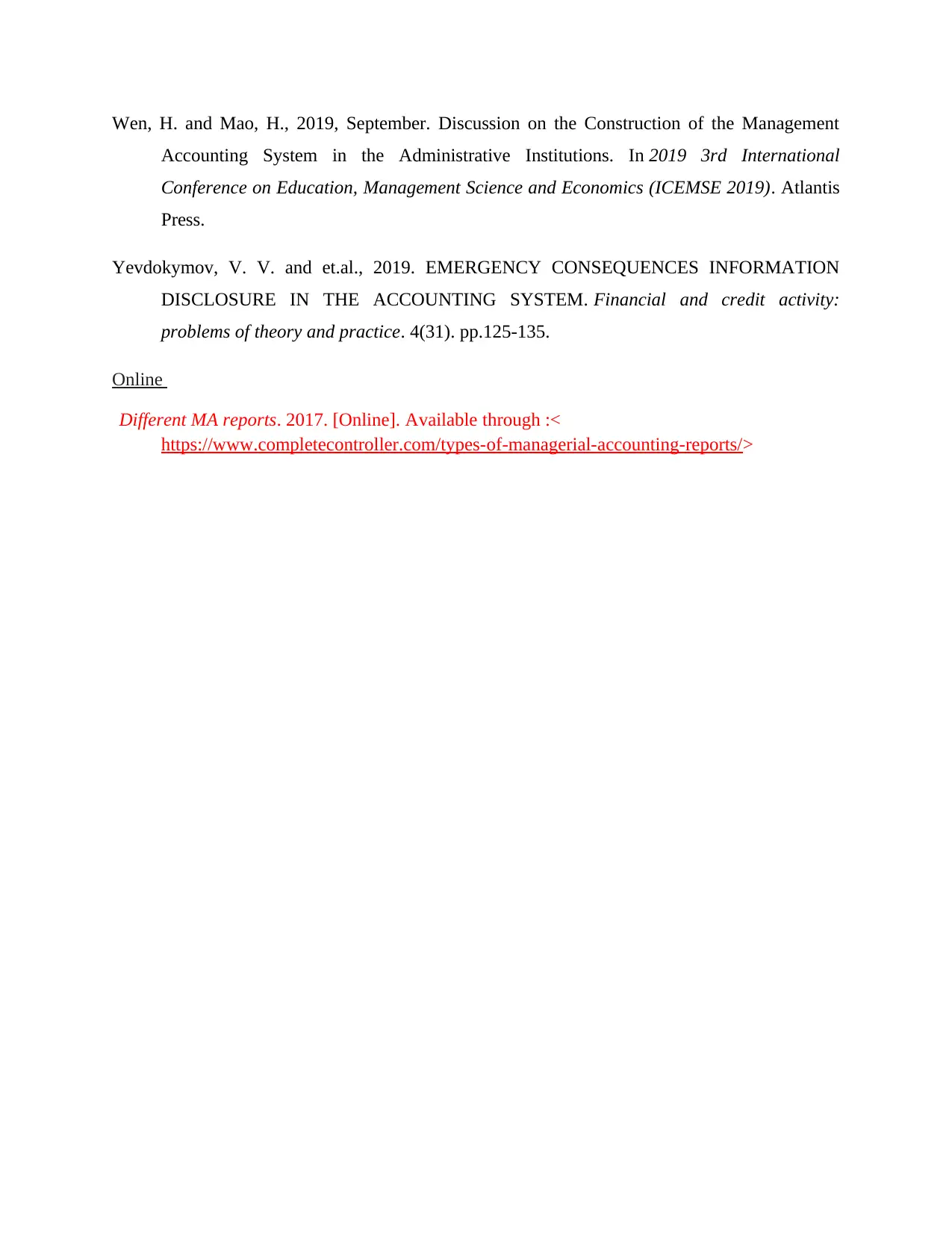
Wen, H. and Mao, H., 2019, September. Discussion on the Construction of the Management
Accounting System in the Administrative Institutions. In 2019 3rd International
Conference on Education, Management Science and Economics (ICEMSE 2019). Atlantis
Press.
Yevdokymov, V. V. and et.al., 2019. EMERGENCY CONSEQUENCES INFORMATION
DISCLOSURE IN THE ACCOUNTING SYSTEM. Financial and credit activity:
problems of theory and practice. 4(31). pp.125-135.
Online
Different MA reports. 2017. [Online]. Available through :<
https://www.completecontroller.com/types-of-managerial-accounting-reports/>
Accounting System in the Administrative Institutions. In 2019 3rd International
Conference on Education, Management Science and Economics (ICEMSE 2019). Atlantis
Press.
Yevdokymov, V. V. and et.al., 2019. EMERGENCY CONSEQUENCES INFORMATION
DISCLOSURE IN THE ACCOUNTING SYSTEM. Financial and credit activity:
problems of theory and practice. 4(31). pp.125-135.
Online
Different MA reports. 2017. [Online]. Available through :<
https://www.completecontroller.com/types-of-managerial-accounting-reports/>
1 out of 20
Related Documents
Your All-in-One AI-Powered Toolkit for Academic Success.
+13062052269
info@desklib.com
Available 24*7 on WhatsApp / Email
![[object Object]](/_next/static/media/star-bottom.7253800d.svg)
Unlock your academic potential
© 2024 | Zucol Services PVT LTD | All rights reserved.





